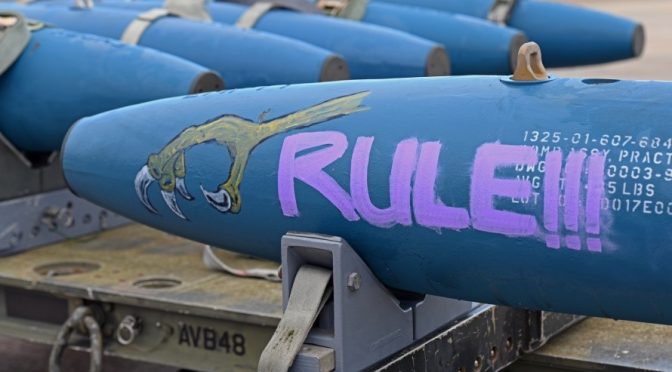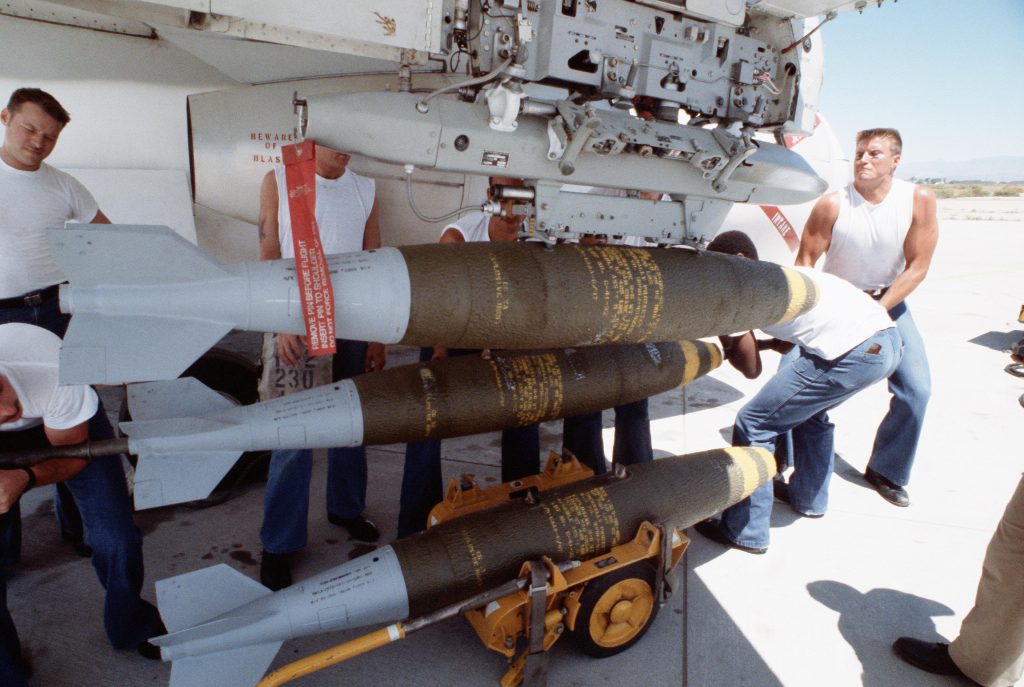
Bombing-up an S-3A Viking with Mk82s. U.S. Navy photo by Photographer’s Mate First Class Michael D.P. Flynn, 01FEB1988.
The Mark 82 (aka BDU) is a 5-hundred pound/227-kilogram unguided ‘vehicle’ (practice bombs about 400lbs/181kg) designed to hit your enemy with 192 pounds/87-kilograms of Tritonal high explosive. 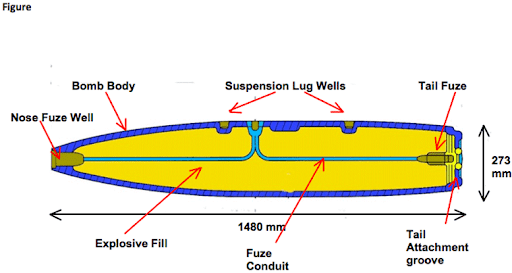 It was first used during the U.S. occupation of Vietnam. It’s part of the Mark 80 series of low-drag bombs, from Mk81 to Mk84, of similar shape but increasing size.
It was first used during the U.S. occupation of Vietnam. It’s part of the Mark 80 series of low-drag bombs, from Mk81 to Mk84, of similar shape but increasing size.
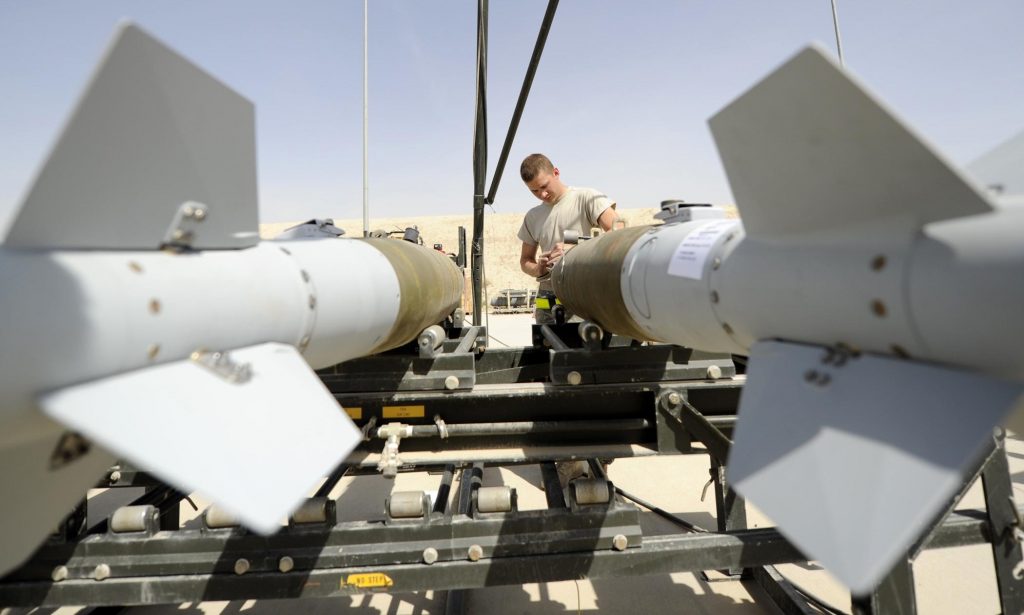
Mark 82s on Kandahar Airfield, Afghanistan. U.S. Air Force photo by Staff Sergeant Stephen Schester, 27APR2010.
The shape and size of the standard fins have changed over the decades, and the type of fins used changes the nomenclature (the various fins/tail cones have their own nomenclatures as well).
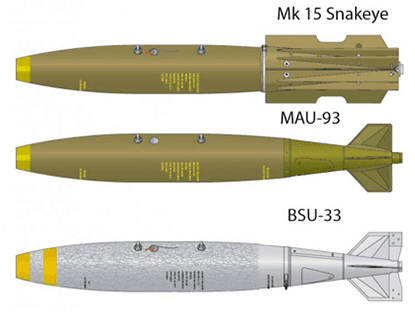
They’ve even been fitted with nose fuse extensions.
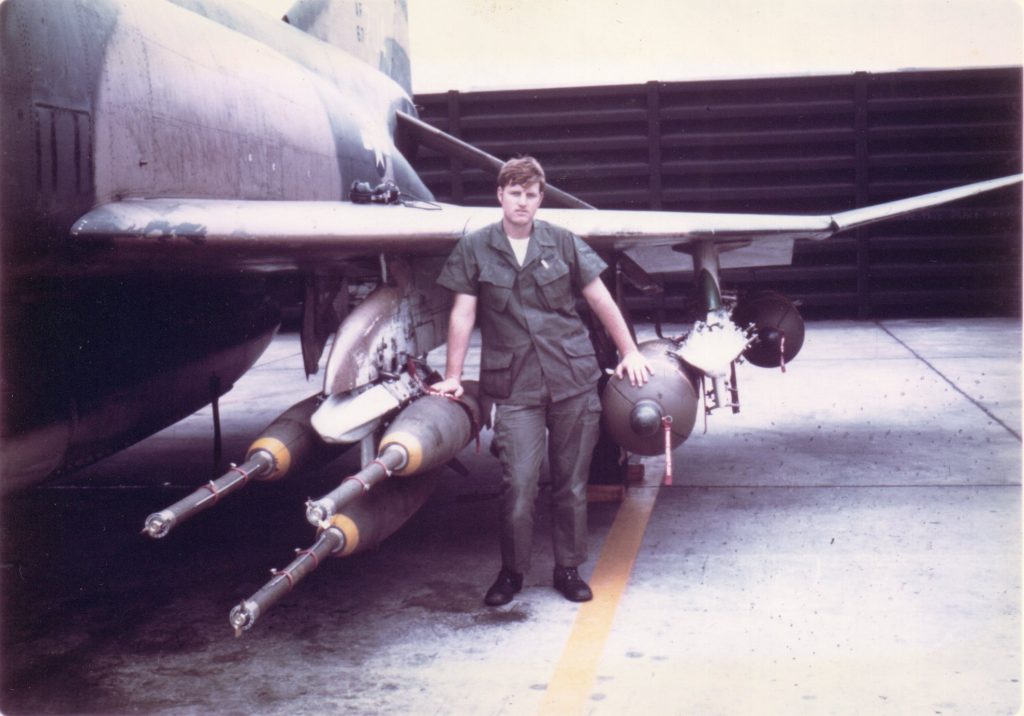
This video is about the history of the F-4 Phantom-2, but it has a couple of scenes from Vietnam in which F-4s off-load massive amounts of Mk82s:
Most ‘live’ Mk82s are painted olive drab with yellow markings and trim. Some are light grey with yellow trim. Yellow indicates it is a ‘live’ bomb.
“Bombs can be filled by conventional explosive or other explosive compositions (TNT, Tritonal, Comp B) with a wide range of fuzes (M904-M905, FMU-139, FMU-152, FBM 21, ID 260).”
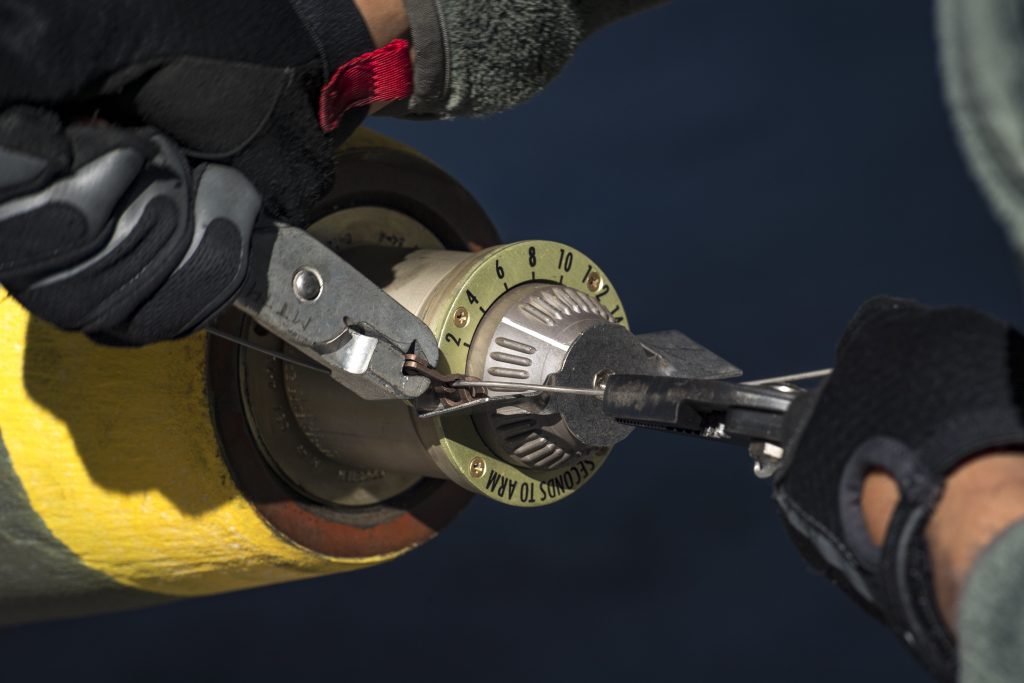
USAF photo by Staff Sergeant Ryan Callaghan, 25JAN2017.
This live Mk82 has a nose mounted M904 fuse.
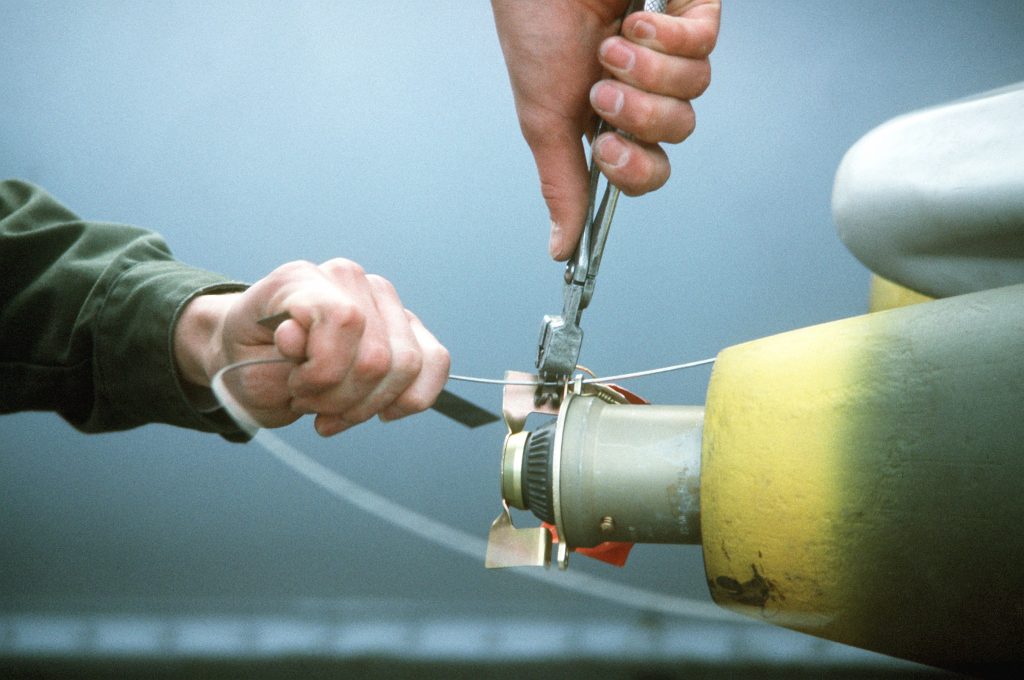
USAF photo by Master Sergeant Don Sutherland, 01FEB1981.
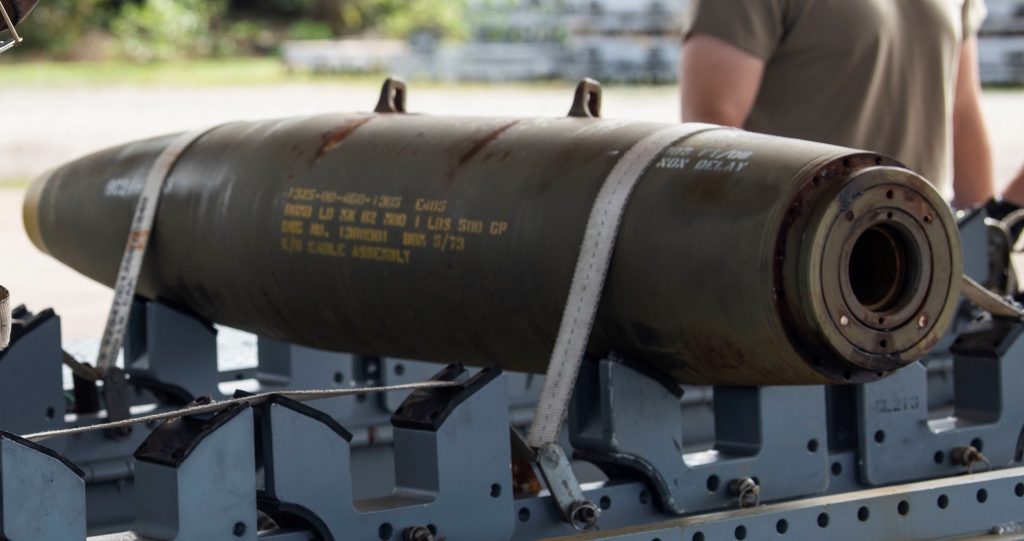
USAF photo by Senior Airman Zachary Heal, 05FEB2020.
Many bombs have varying shades of paint from one to the other, depending on how they were stored, exposure to sunlight, etc.
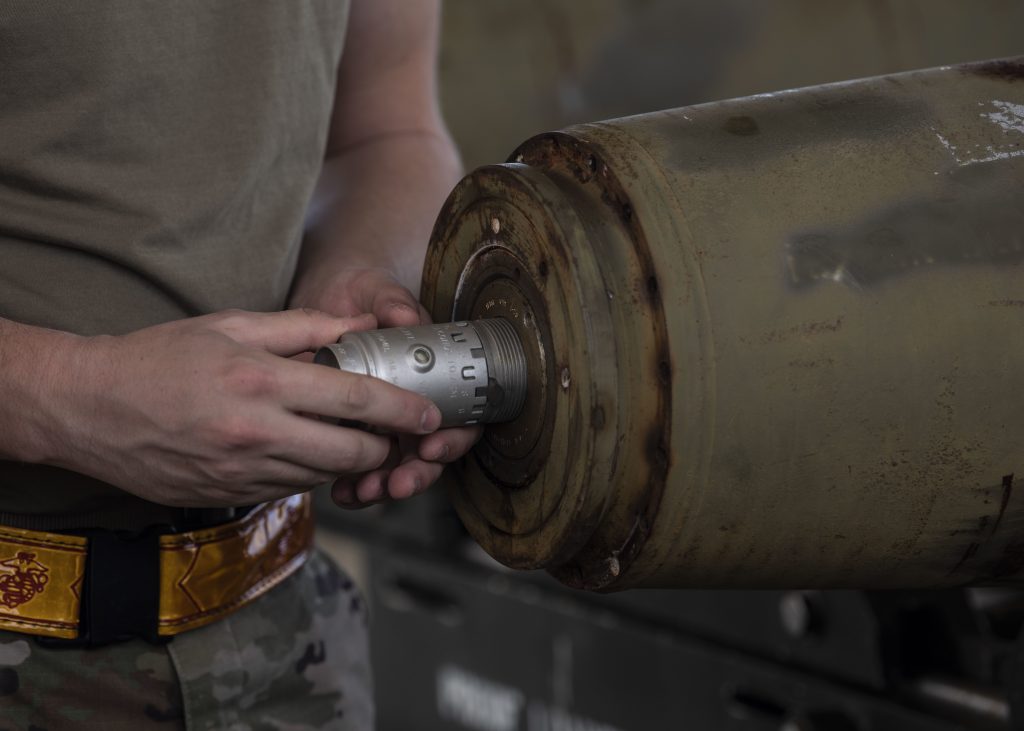
USAF photo by Senior Airman Zachary Heal, 05FEB2020.
This live Mk82 has a rear mounted M905 fuse.
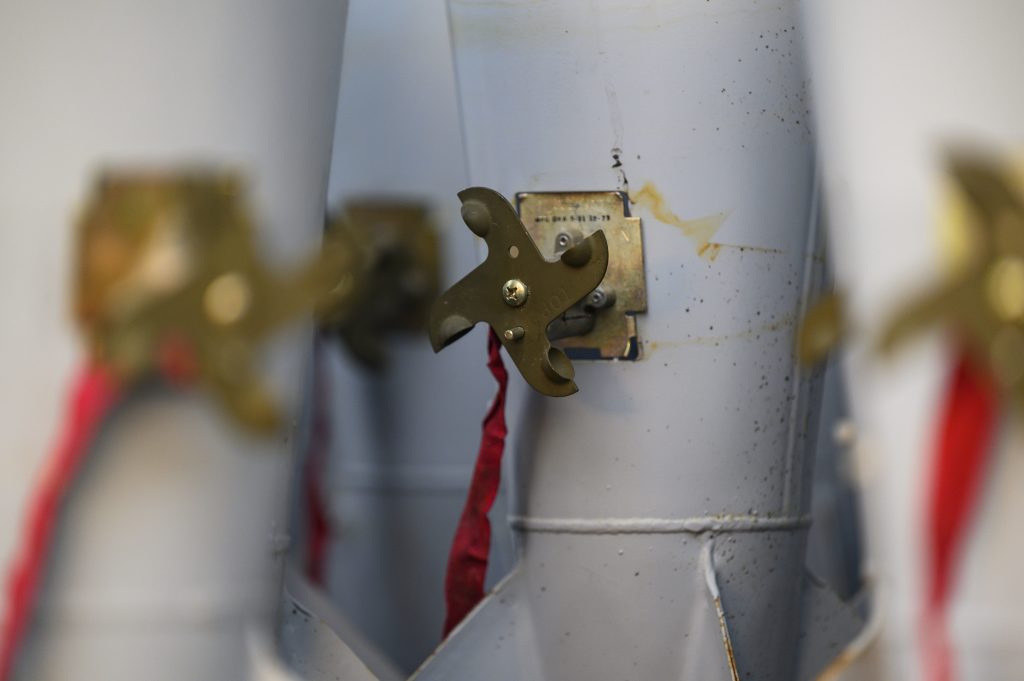
USAF photo by Senior Airman Jacob M. Thompson, 27JAN2021.
Some tail cones have ‘pinwheels’ (ATU-35A/B tail mounted fuse drive assemblies) that have an arming wire connected to the bomb release mechanism. The ATU-35 is for both the M904 nose fuse and the M905 rear mounted fuse.
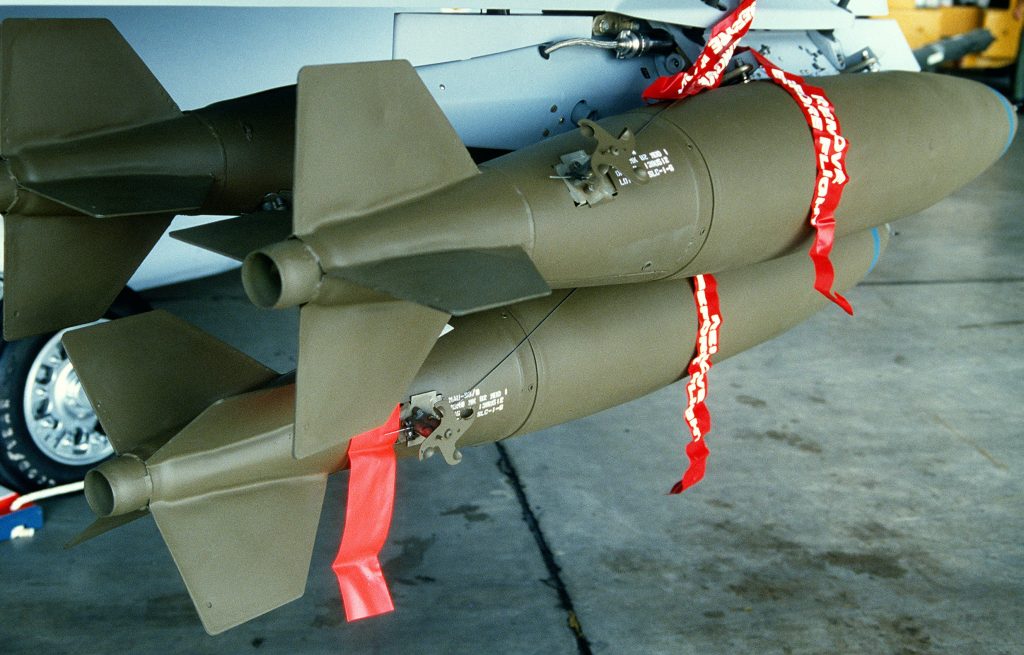
Pinwheels on the tail cones of these practice bombs, denoted by the blue stripe around the nose. USAF photo by Master Sergeant Ken Hammond, 27JUN1987.
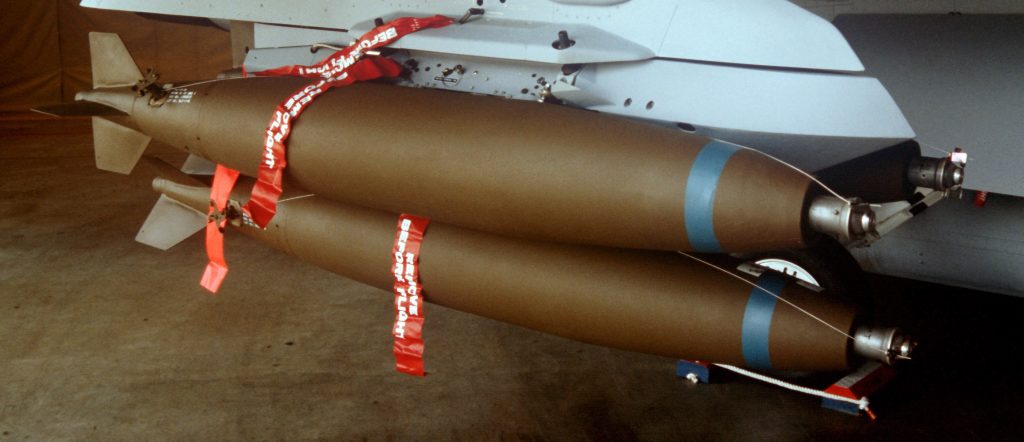
These Mk82s have the M904 nose fuse with the ATU-35 tail drive. USAF photo by Master Sergeant Ken Hammond, 27JUN1987.
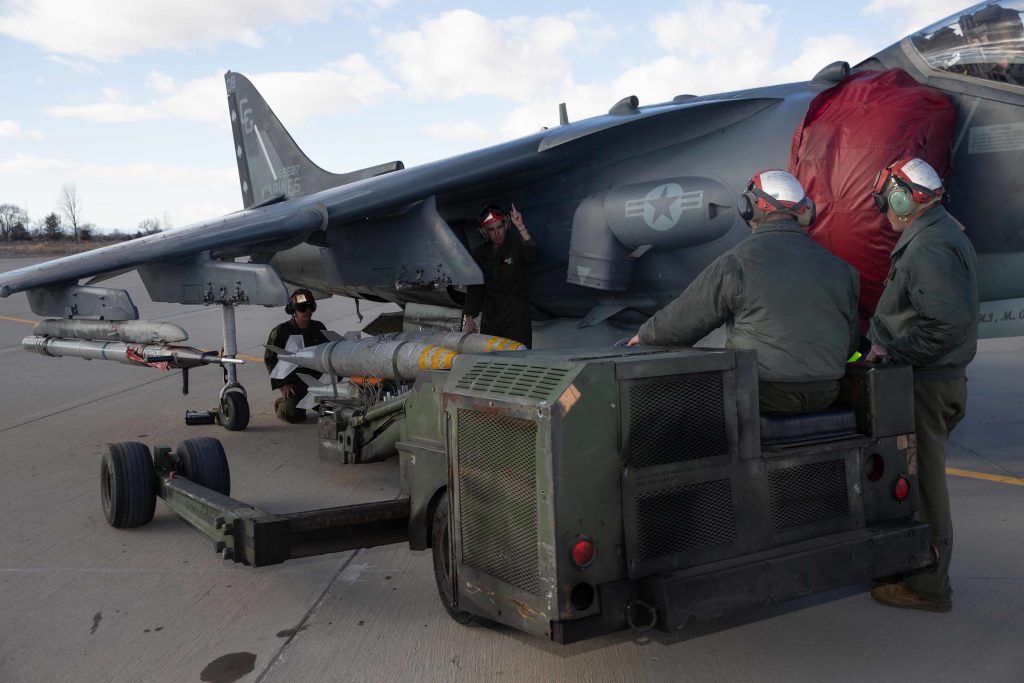
U.S. Marine Corps photo by Lance Corporal Steven Walls, 28JAN2020.
The live Mk82s (BSU-33s?) on this AV-8B Harrier are grey with yellow trim. Note the USMC fins are the similar to the USAF fins.
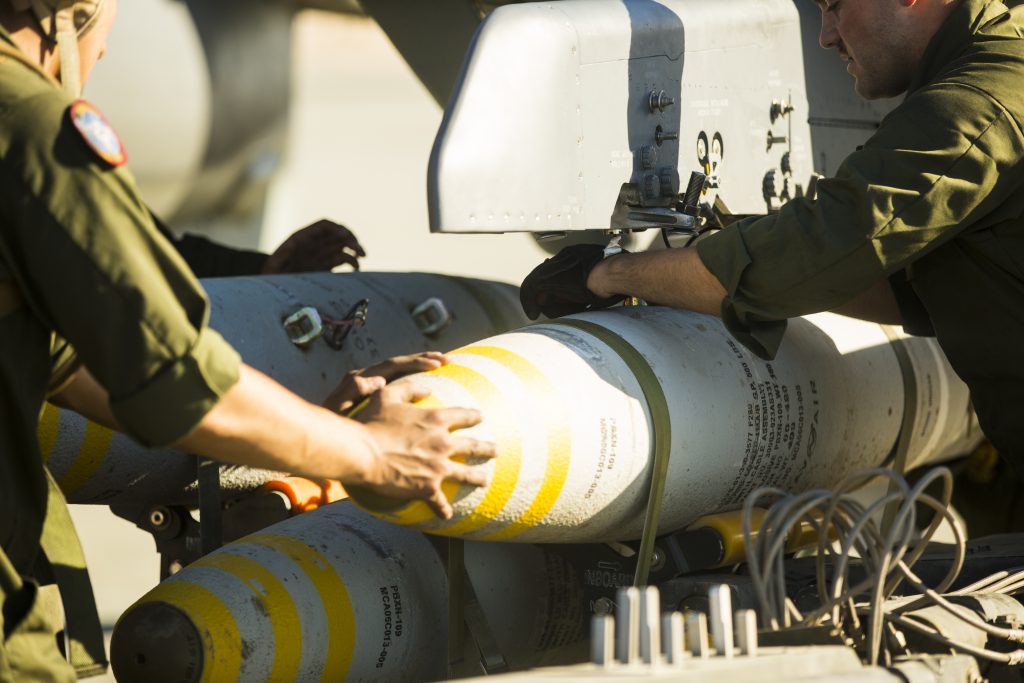
USMC photo by Lance Corporal James Marchetti, 14JAN2014.
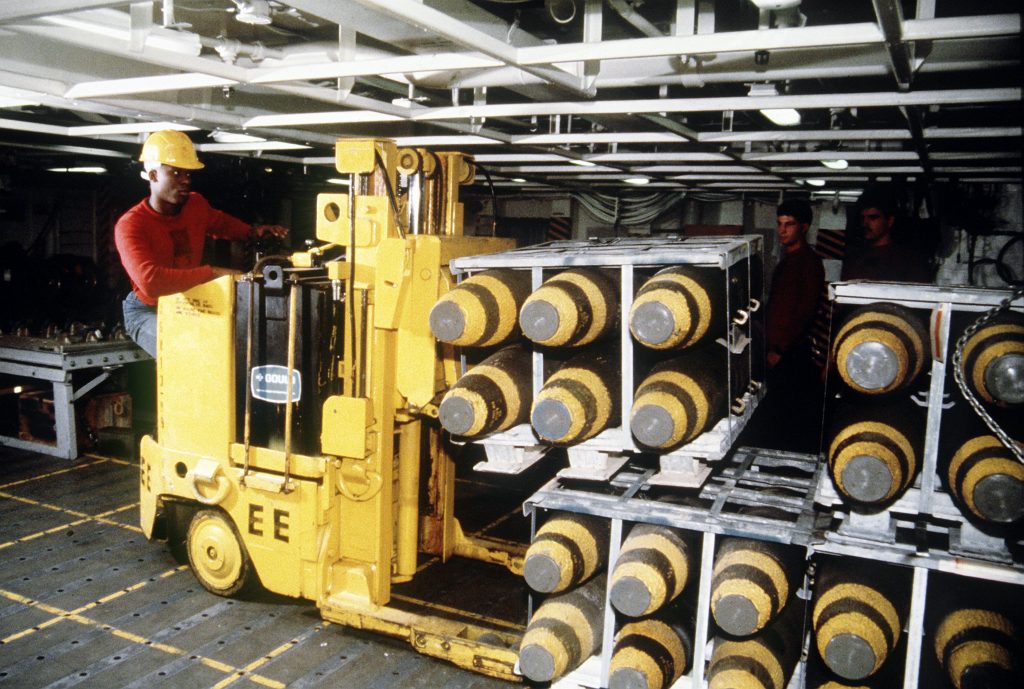
Mark 82s onboard aircraft carrier USS Abraham Lincoln (CVN-72). USN photo by Photographer’s Mate Second Class Tracy Lee Didas, 01OCT1989.
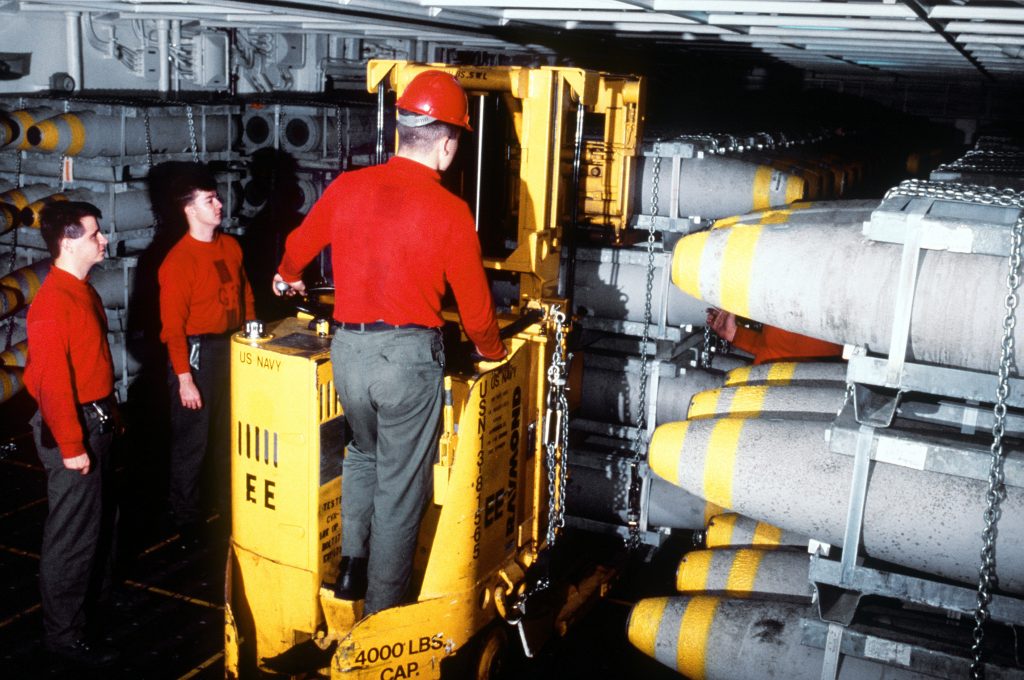
Same aircraft carrier, but in 1993. Mark 82s onboard aircraft carrier USS Abraham Lincoln (CVN-72). USN photo by Photographer’s Mate Second Class Hayhurst, 01OCT1993.
For those model builders who are worried that they’ve hit their Mark 82s/BDUs with a paint bomb, most U.S. Navy/USMC bombs have a thick stucco looking coating of paint.
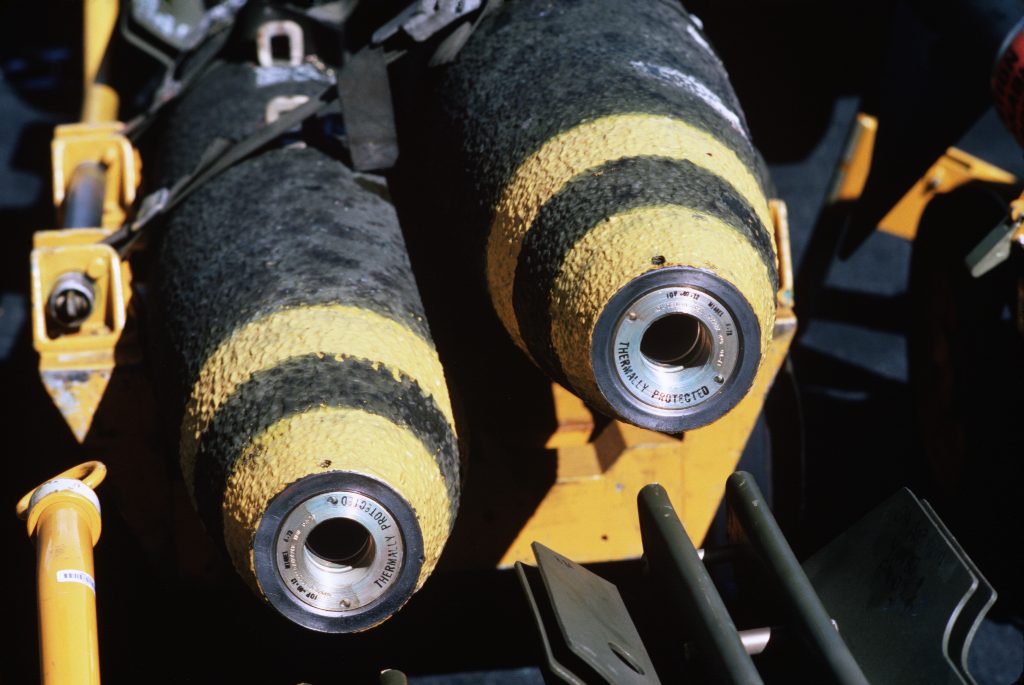
USN photo by Photographer’s Mate Second Class Tracy Lee Didas, 04NOV1987.
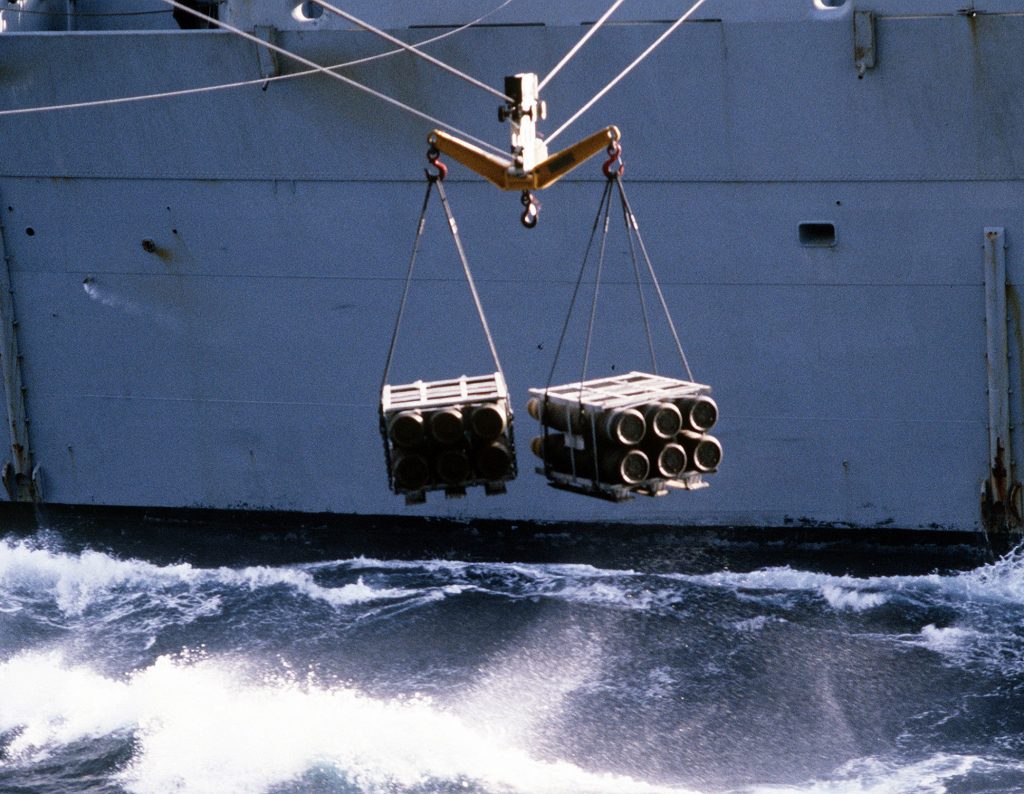
Mark 82s being transferred from ship-to-ship during Desert Storm. USN photo by Photographer’s Mate Second Class Charles W. Moore, 01FEB1991.
Video, 726th EABS Munitions Systems team shows you how to build a Mk82, November 2019, Djibouti:
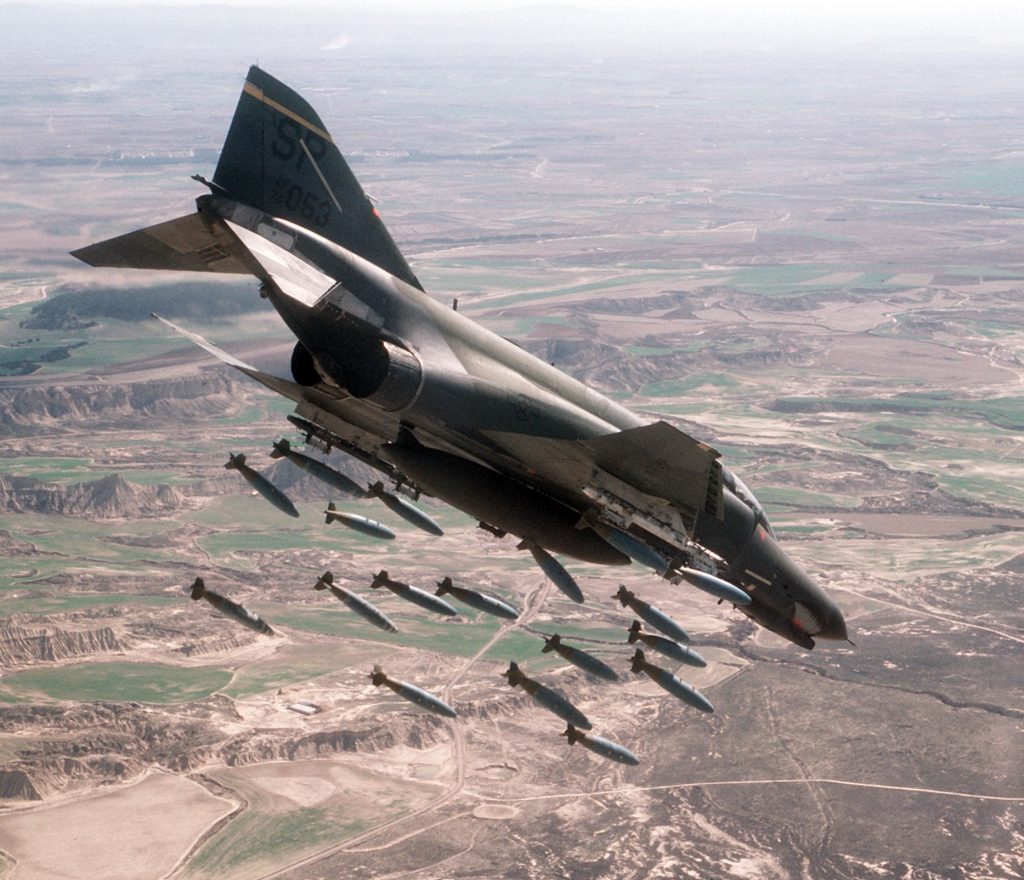
An F-4E Phantom II off-loads a bunch of blue bombs onto the Bardenas Bombing Range in Spain. USAF photo by Staff Sergeant David Nolan, 25MAR1986.
Practice bombs are painted blue, or O-D with blue trim and fins. Some are so old the blue paint is extremely faded. Some practice bombs have spotting charges in the fin section to make it easier to spot where it impacts on the target field.
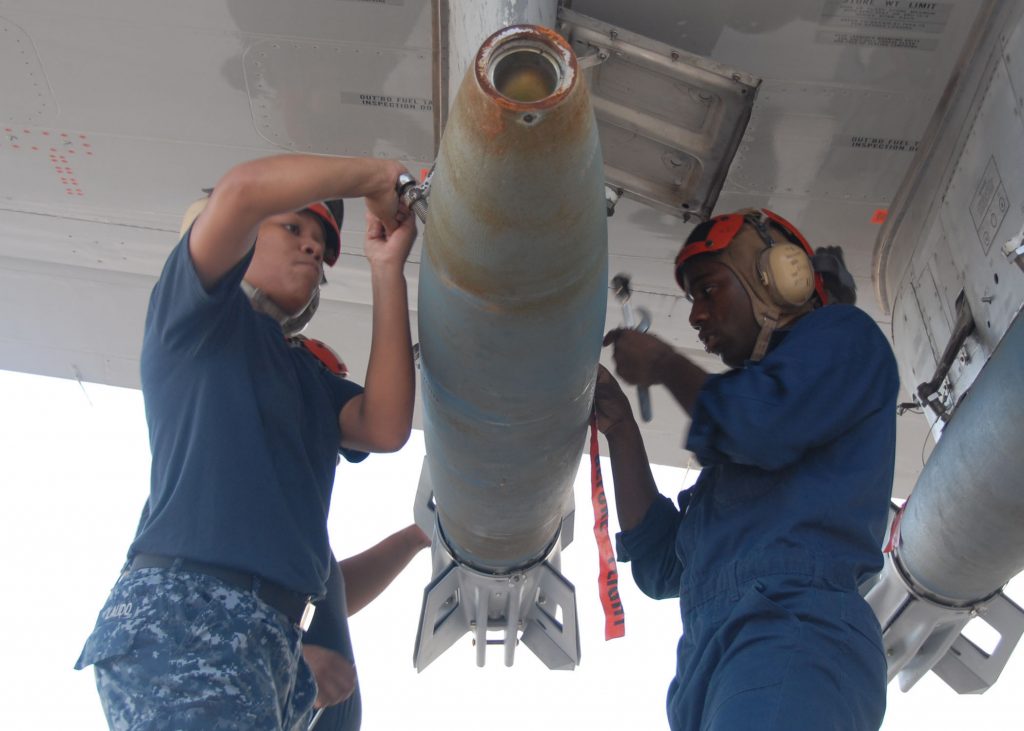
BDU-45 mounted on P3C Orion. USN photo by Mass Communication Specialist Second Class Harry J. Rucker the Third, 25OCT2009.
The U.S. Navy calls their practice Mk82 bomb the BDU-45. Note there is a difference between USN fins and USAF fins.
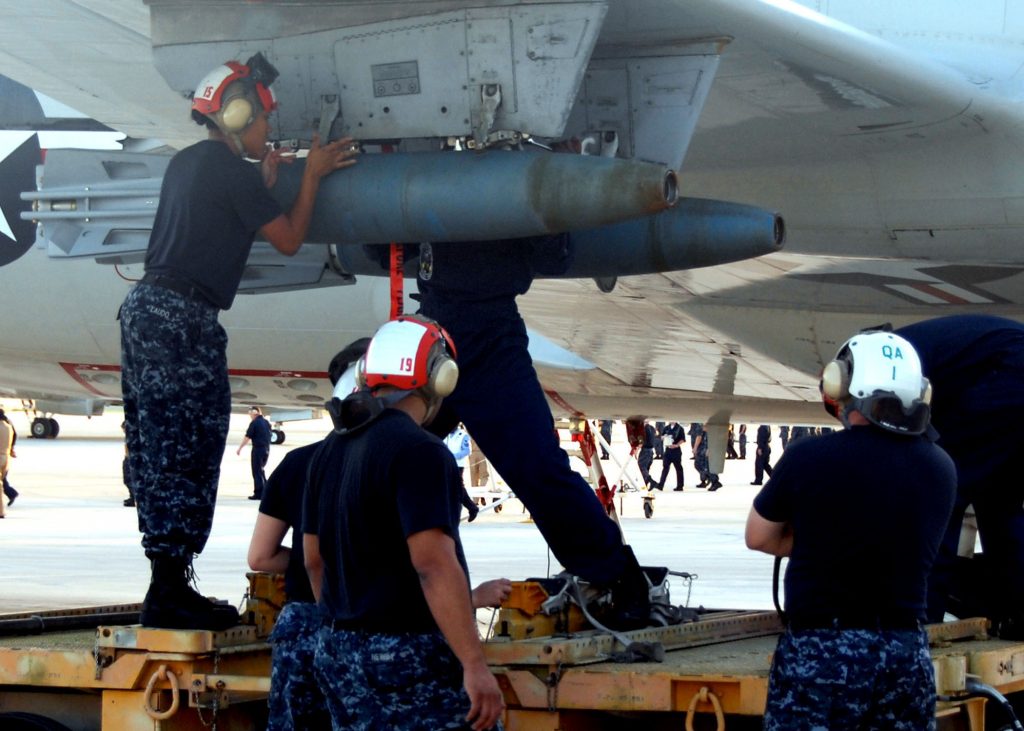
BDU-45 mounted on P3C Orion. USN photo by Mass Communication Specialist Second Class Harry J. Rucker the Third, 25OCT2009.
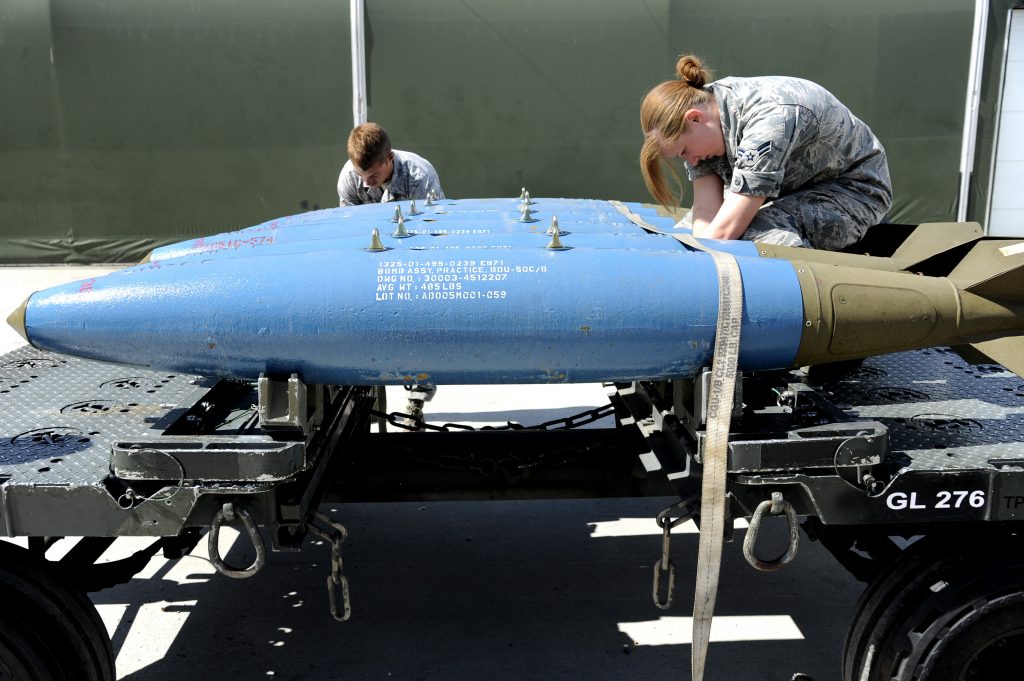
USAF photo by Staff Sgt. Jim Araos, 02JUL2012.
Blue bombs.
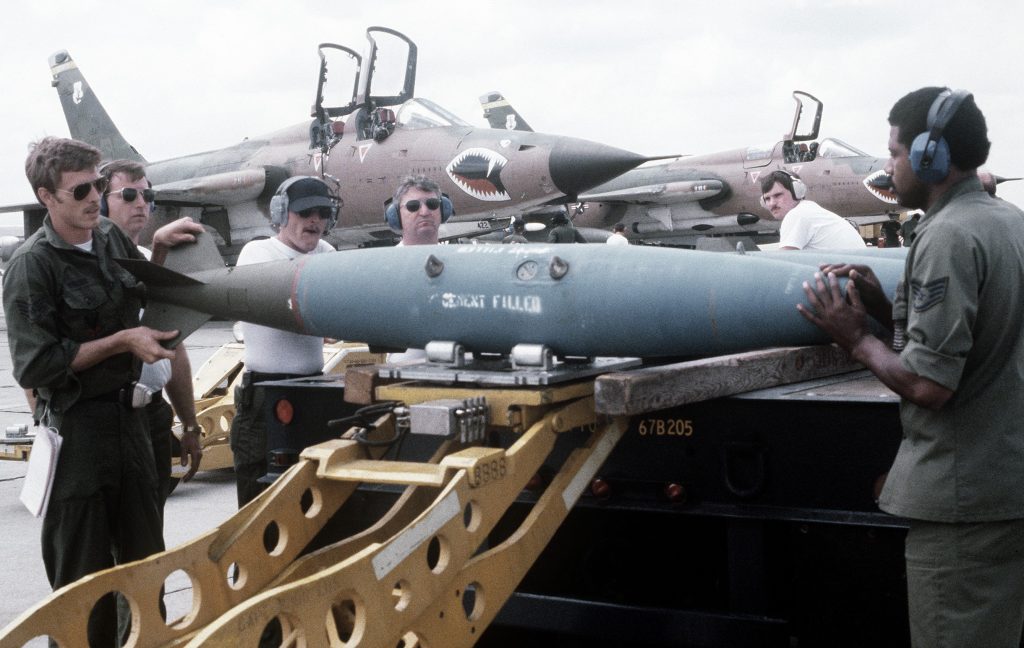
Georgia Air National Guard F-105G gets bombed-up with a cement filled Blue Bomb. Photo by Airman First Class Sheryl D. Barnett, 10APR1981.
Video, Davis Monthan, Arizona, Operation SnowBird 2013, Idaho National Guard bombs-up their A-10s with Maverick missiles and Mk82s:
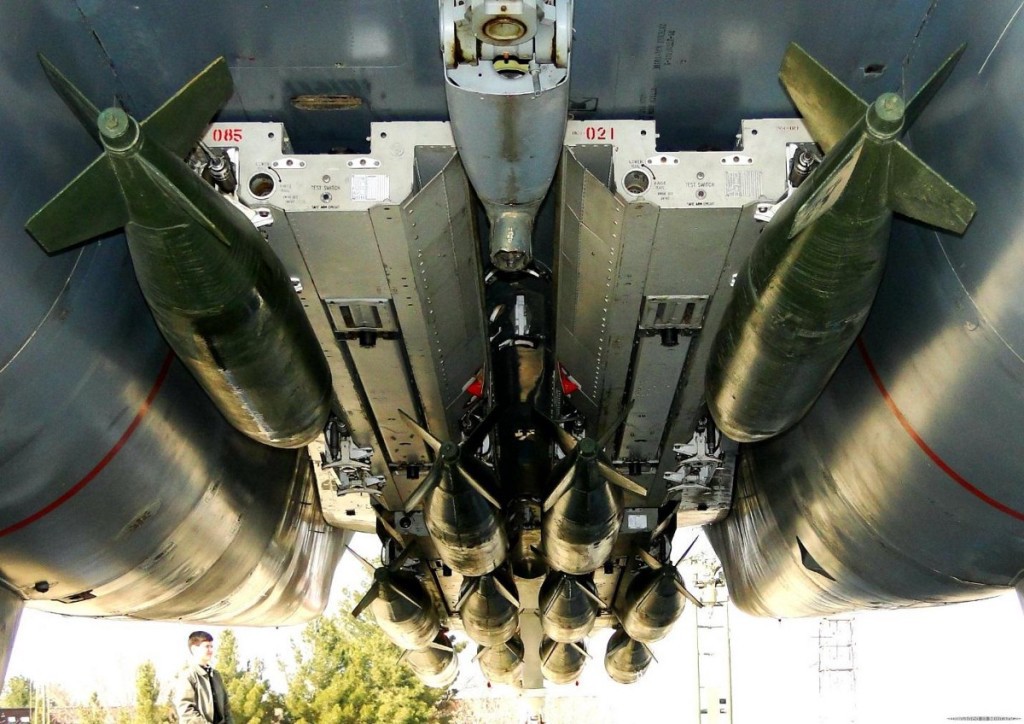 An Iranian F-14 tomcat bombed-up with Iranian made Mk82s on Iranian designed bomb rack.
An Iranian F-14 tomcat bombed-up with Iranian made Mk82s on Iranian designed bomb rack.
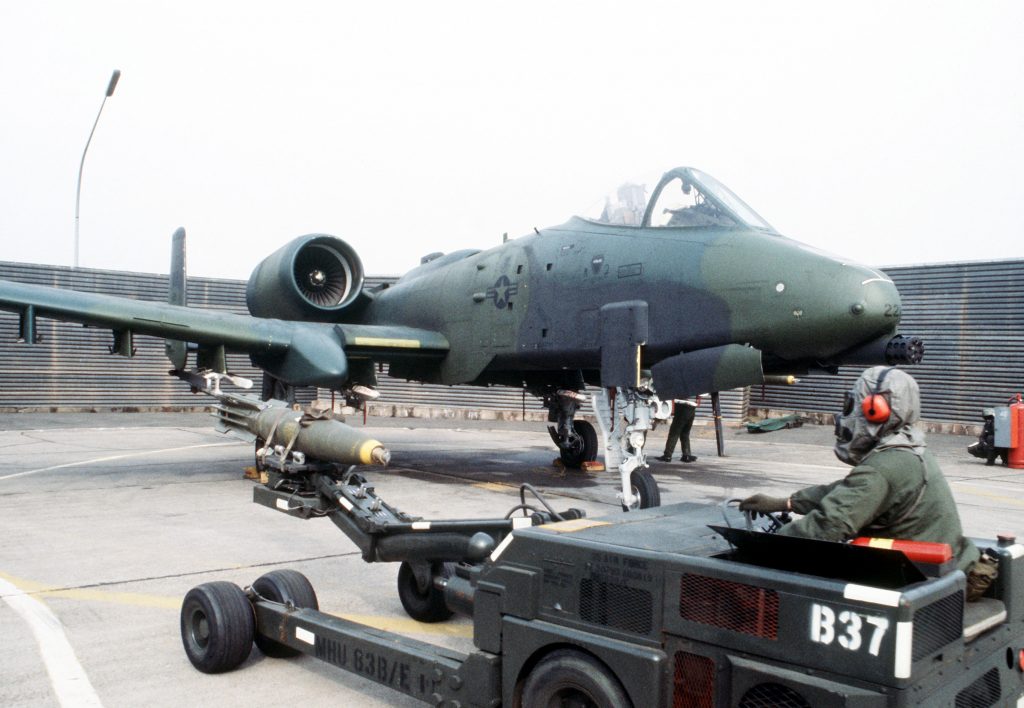
A-10A on Sembach Air Base, Germany, being bombed-up with a Mk82 Snake Eye. USAF photo by Sutherland, 22APR1982.
The Mk82 can be fitted with low-drag fins or the infamous high-drag fins called Snake Eye. The Snake Eye, or Mark 14 Tail Retarding Device, was developed because aircraft making low-level bombing runs would get hit by the shrapnel from the low-drag Mk82s.
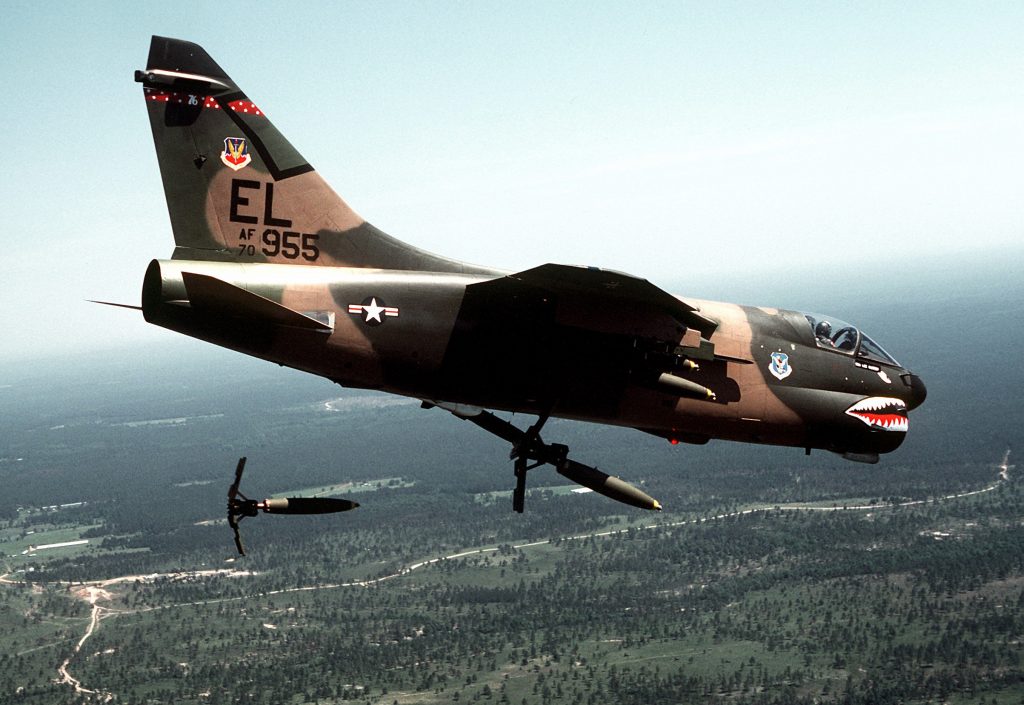
A-7 Corsair II releasing Mark 82 hi-drag (Snake Eye) bombs on bombing range in Florida. USAF photo by Technical Sergeant Frank Garzelnick, 01MAY1980.
The Iranians love the Snake Eye, using it during low-level high-speed bombing runs against invading Iraqi forces in the 1980s and still using it today.
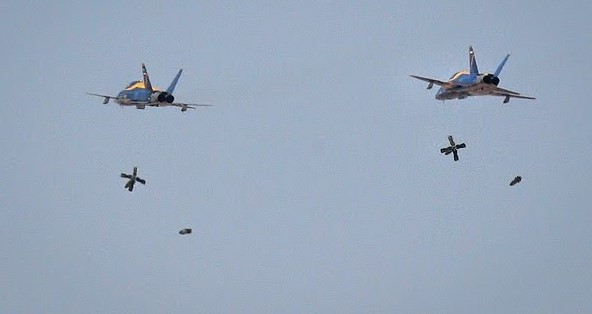 Iranian Thunderbolts (twin tailed F-5s) dropping snake eyes.
Iranian Thunderbolts (twin tailed F-5s) dropping snake eyes.
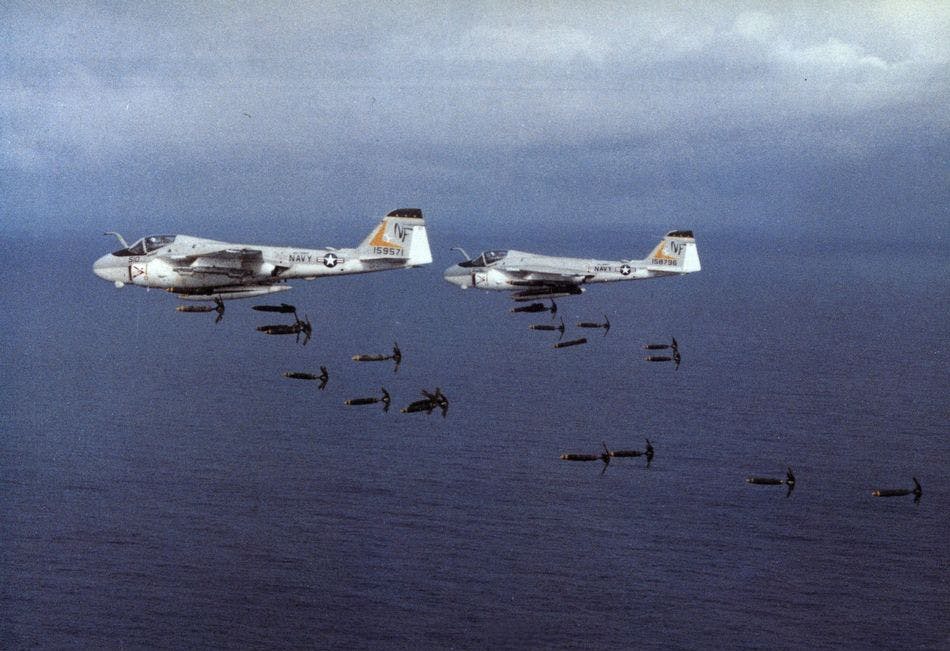 U.S. Navy A-6 Intruders dropping snake eyes.
U.S. Navy A-6 Intruders dropping snake eyes.
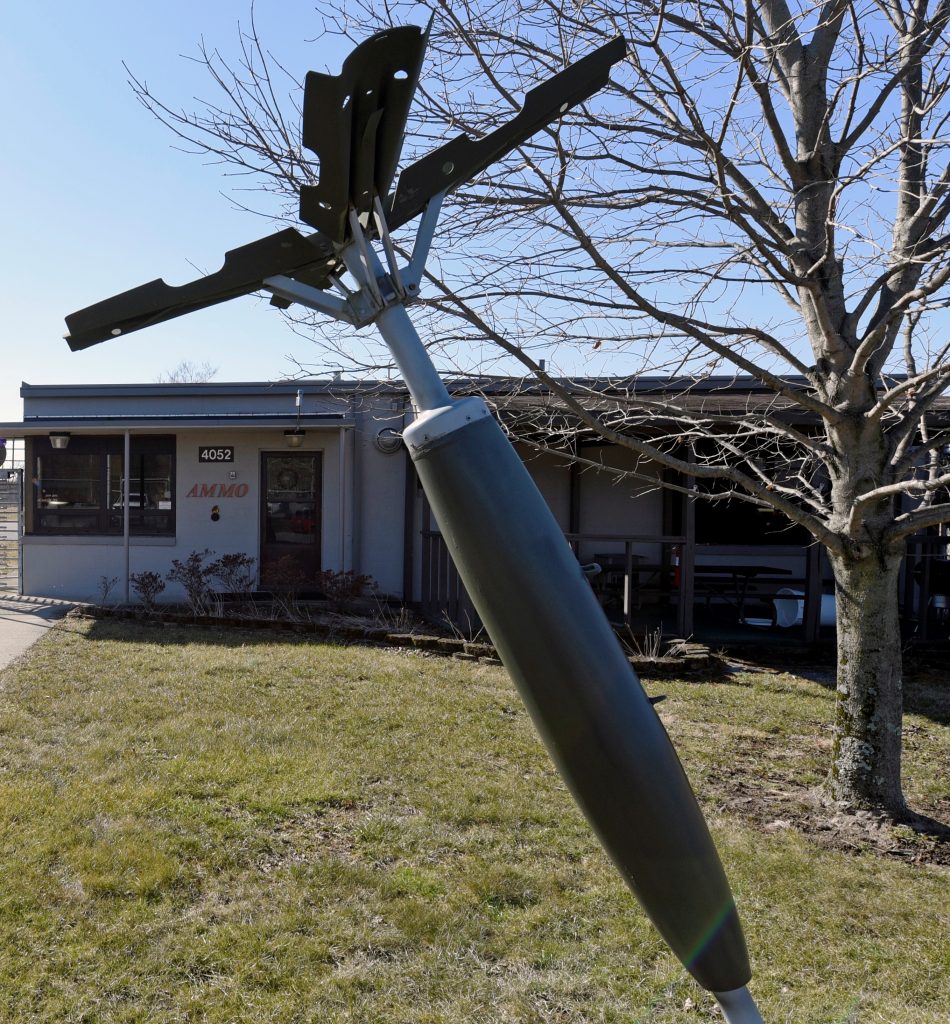
Snake Eye outside the U.S. Air Force 88th Operations Support Squadron, Munitions Flight, at Wright-Patterson Air Force Base, Ohio, 03MAR2021. USAF photo by Ty Greenlees.
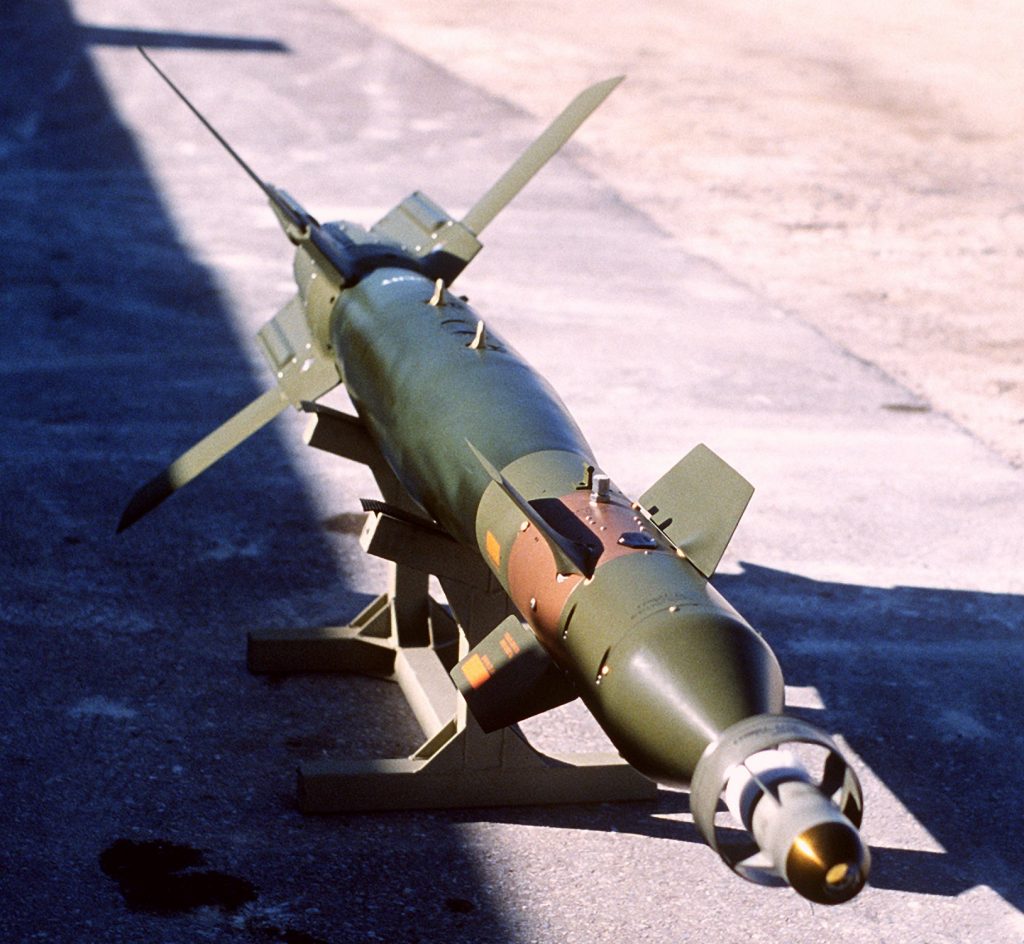
USAF photo by Master Sergeant Dennis L. Carlson, 07DEC1978.
GBU-12 Paveway II is a ‘smart’ Mk82 with laser guidance system.
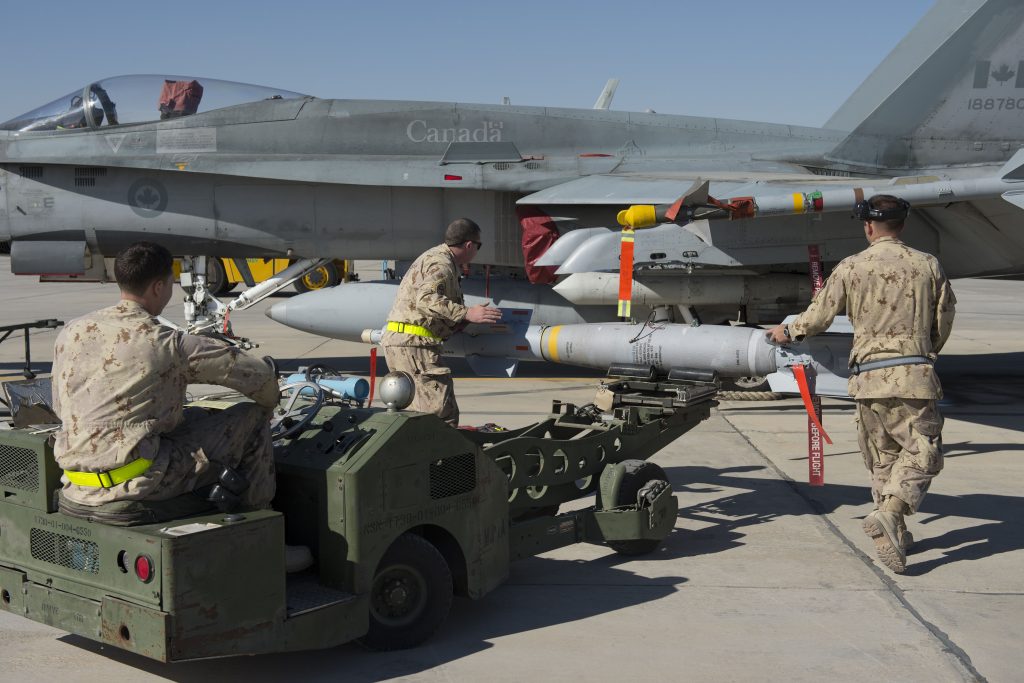
Canadian CF188 (F-18) being bombed-up with a Paveway in Kuwait, 13JAN2015.
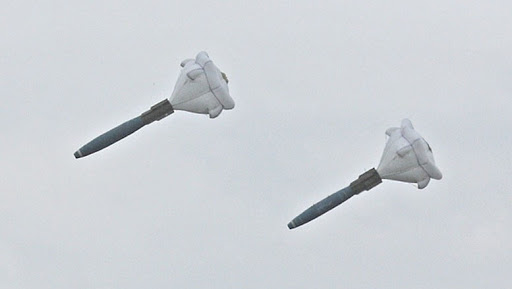 This Mk82 is equipped with the Air Inflatable Retarder (AIR) tail.
This Mk82 is equipped with the Air Inflatable Retarder (AIR) tail.

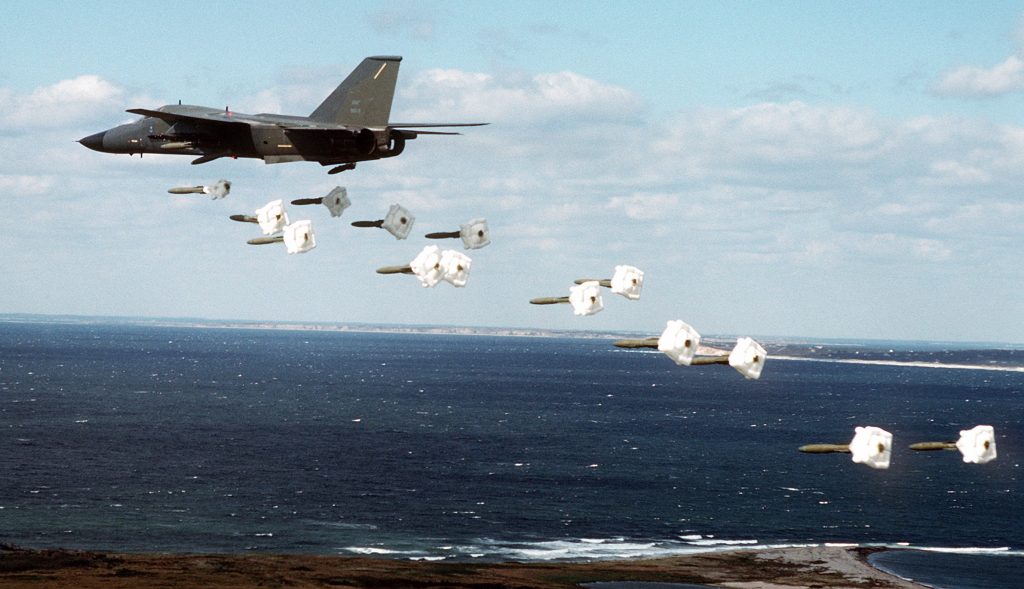
FB-111A off-loads Mk82-AIR bombs, USAF photo by Master Sergeant Ken Hammond, 17NOV1990.
 From 20FEB2020 to 07MAR2020, Army National Guard units from Alaska, Arizona, Colorado, Connecticut, Illinois, Indiana, Mississippi, Missouri, New Hampshire, New York, Pennsylvania, Utah, Washington, West Virginia and Wisconsin, are taking part in Arctic Eagle-20, held in Alaska.
From 20FEB2020 to 07MAR2020, Army National Guard units from Alaska, Arizona, Colorado, Connecticut, Illinois, Indiana, Mississippi, Missouri, New Hampshire, New York, Pennsylvania, Utah, Washington, West Virginia and Wisconsin, are taking part in Arctic Eagle-20, held in Alaska. Also taking place about the same time is Arctic Edge-20, running from 24FEB2020 to 06MAR2020. It includes the U.S. Marine Corps, U.S. Navy, U.S. Air Force, U.S. Coast Guard and Canadian forces.
Also taking place about the same time is Arctic Edge-20, running from 24FEB2020 to 06MAR2020. It includes the U.S. Marine Corps, U.S. Navy, U.S. Air Force, U.S. Coast Guard and Canadian forces.







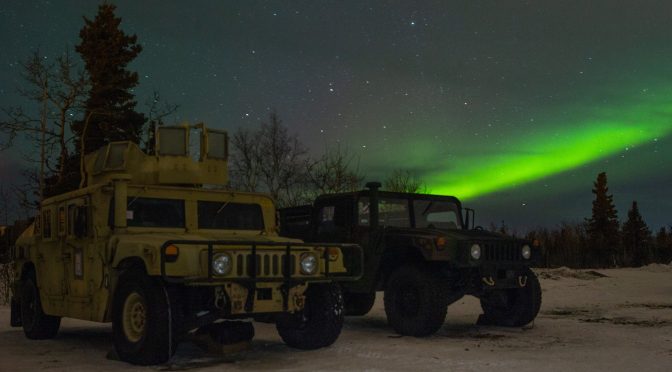
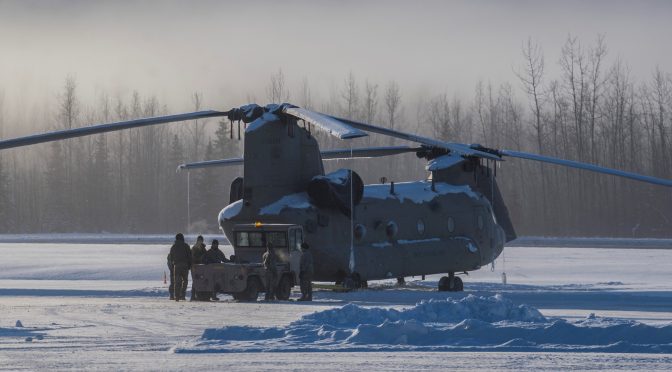
 They’re not really on ice, but ice is on them.
They’re not really on ice, but ice is on them.





 Rotor-wash.
Rotor-wash.







 1:48 scale, first issued 1961.
1:48 scale, first issued 1961. First issued 2006, also boxed by Revell-Germany.
First issued 2006, also boxed by Revell-Germany.
 Black Dog issues resin detail parts, including skis for snow.
Black Dog issues resin detail parts, including skis for snow.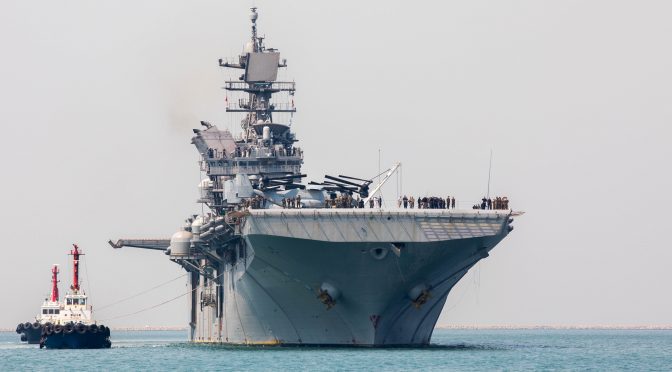
 22FEB2020, Laem Chabang Port, Thailand, Cobra Gold 2020.
22FEB2020, Laem Chabang Port, Thailand, Cobra Gold 2020.






 Countermeasure Washdown System
Countermeasure Washdown System













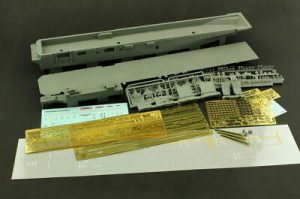



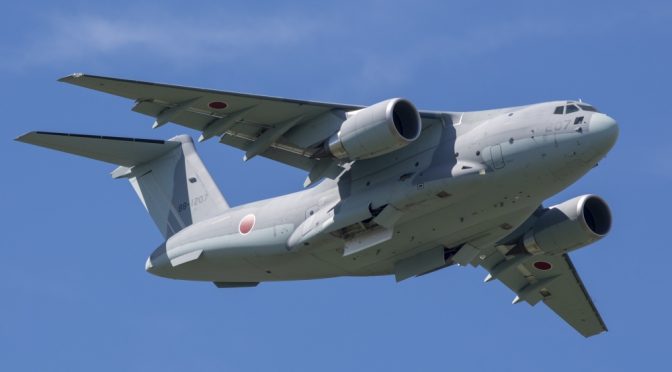

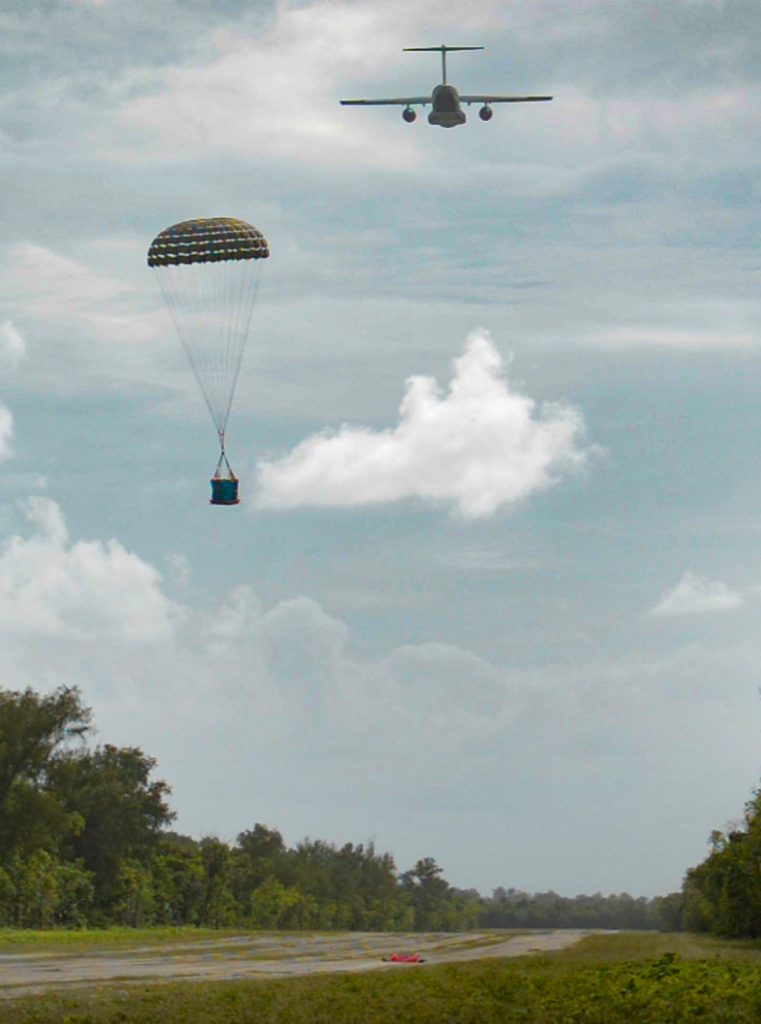
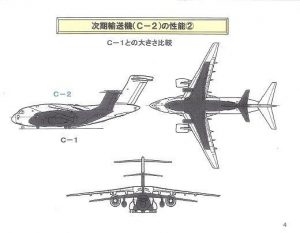
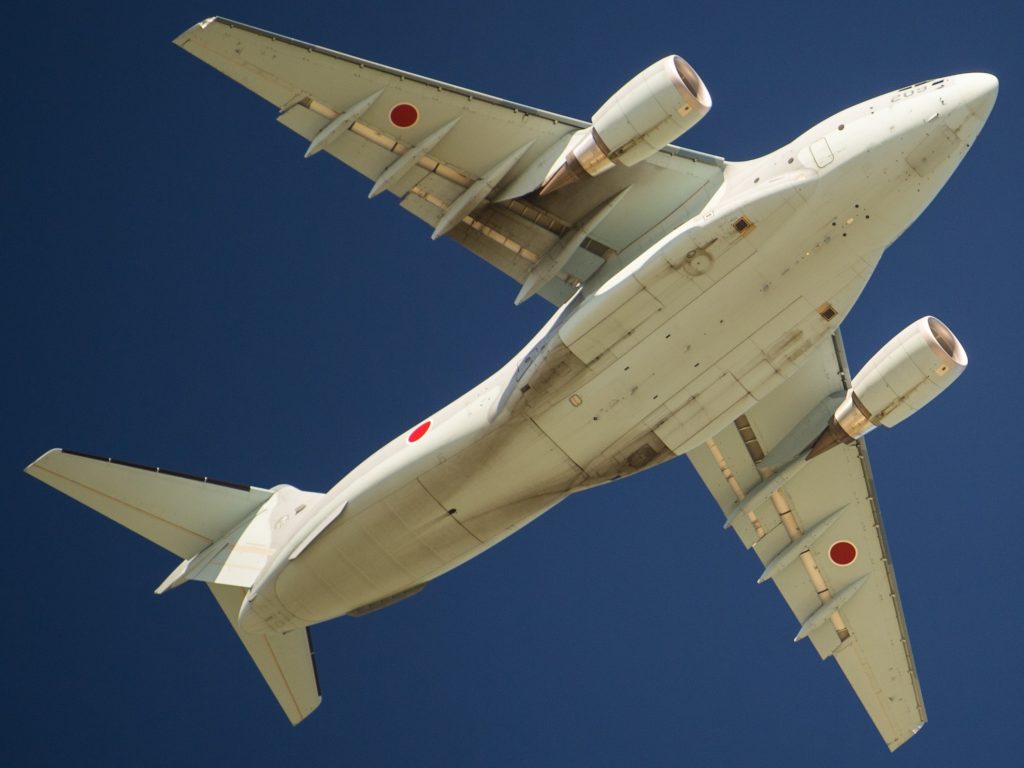


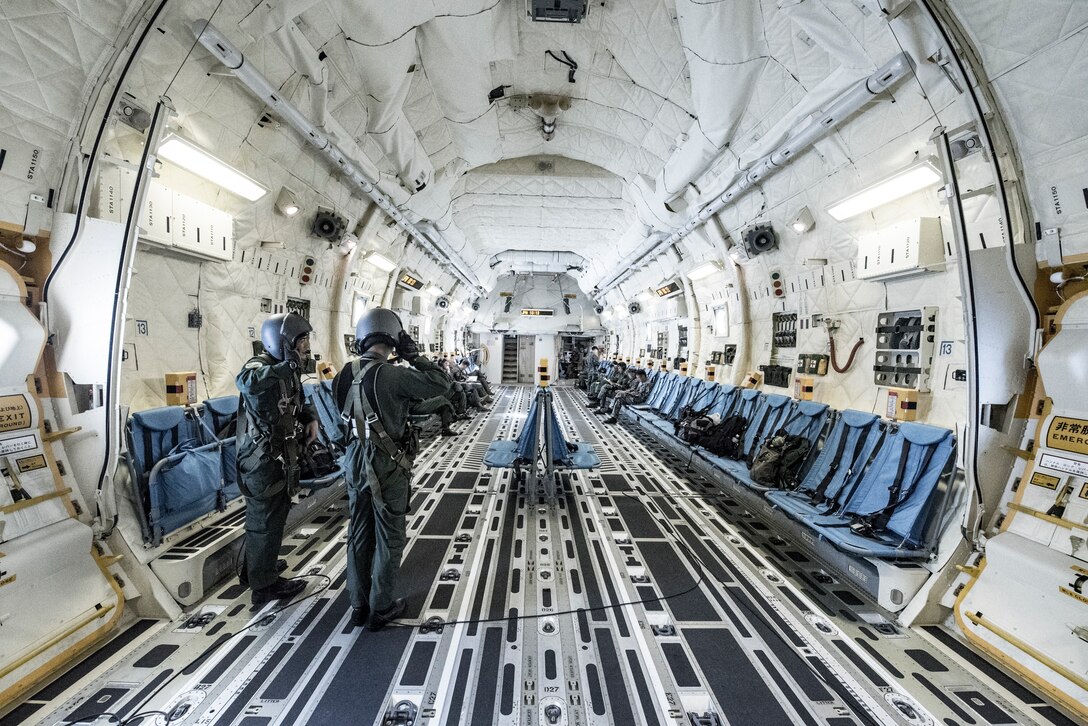
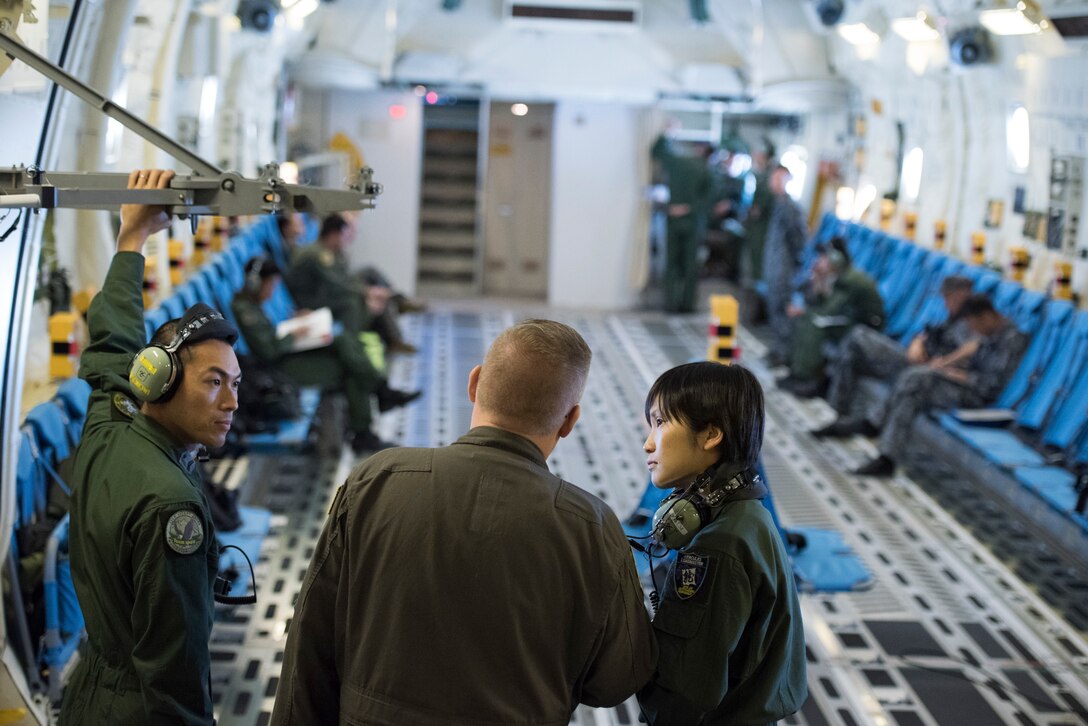

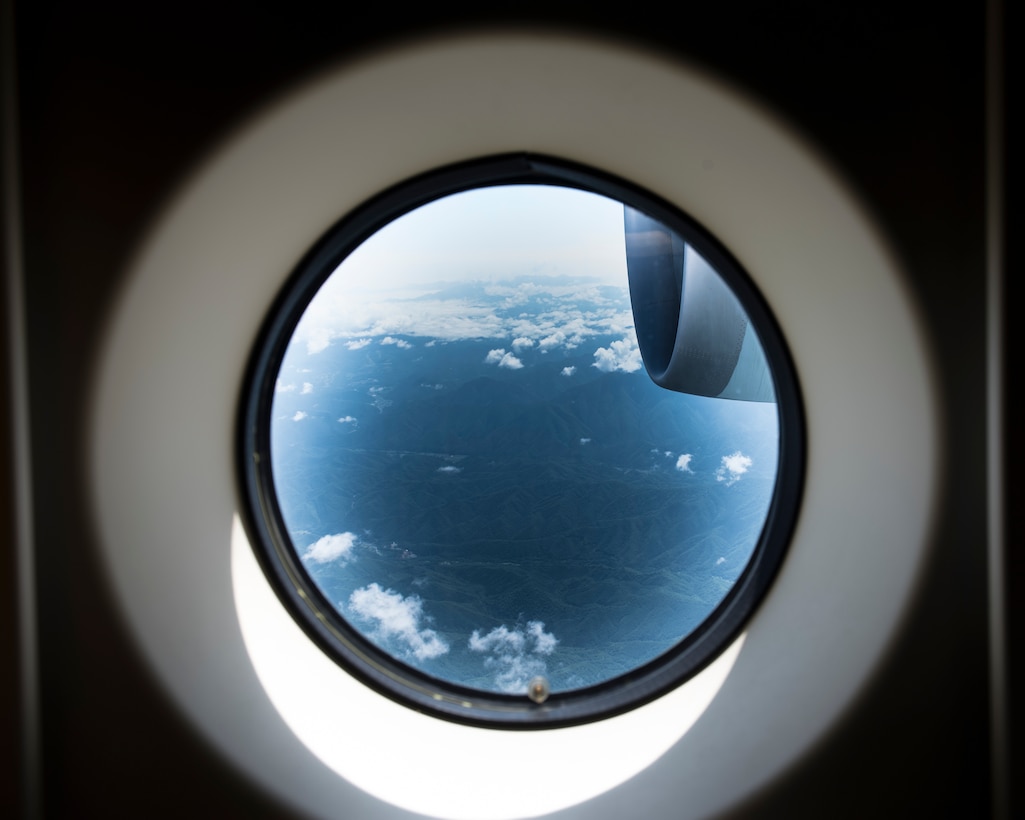
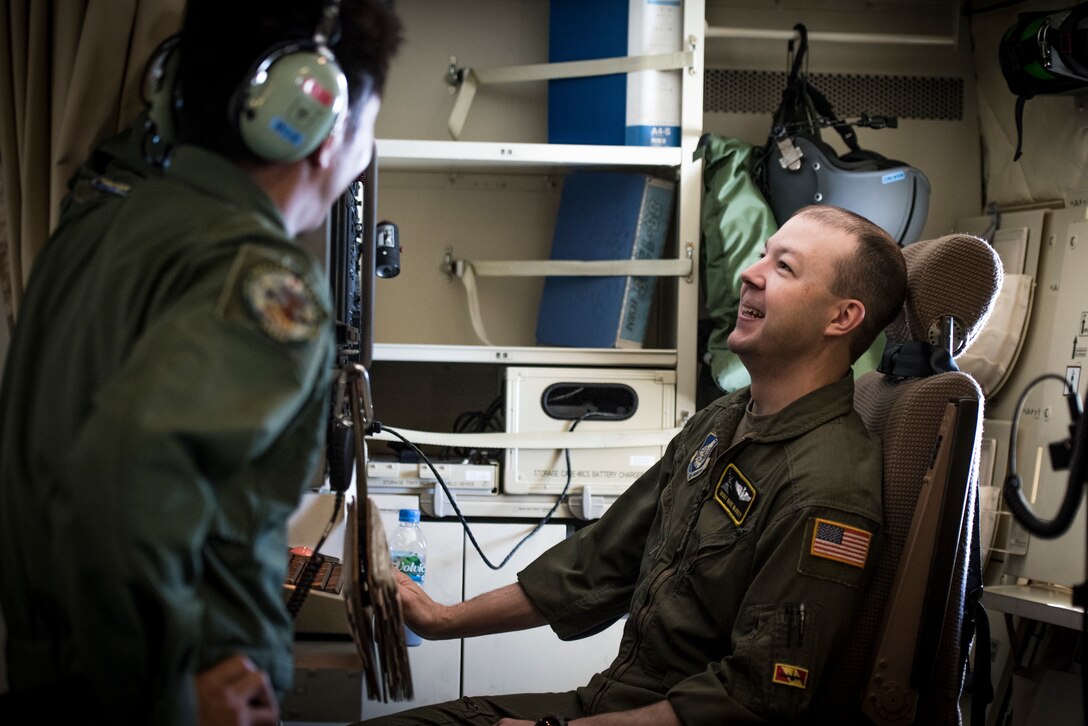
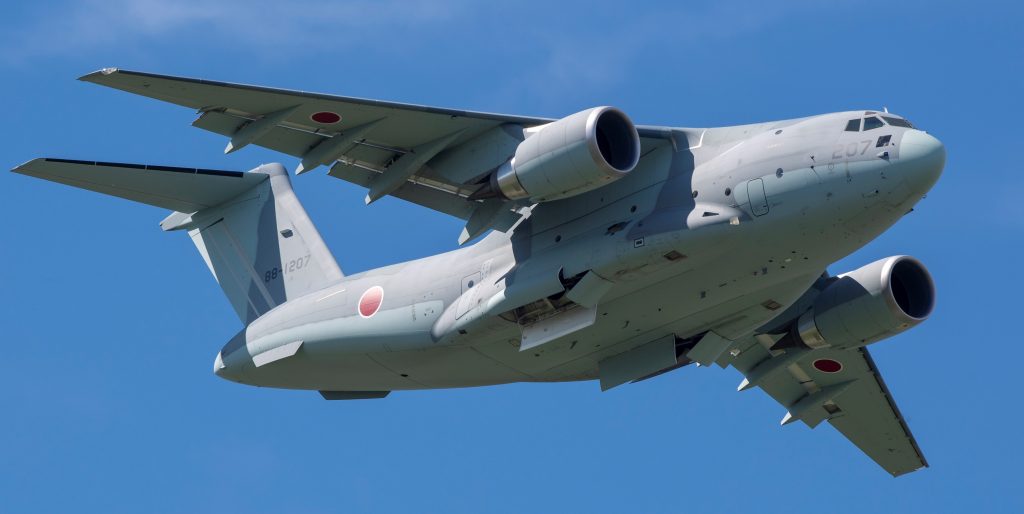

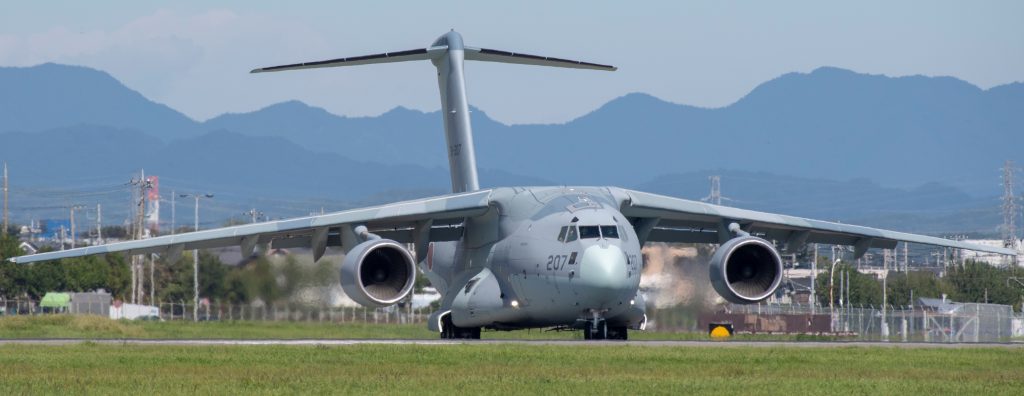
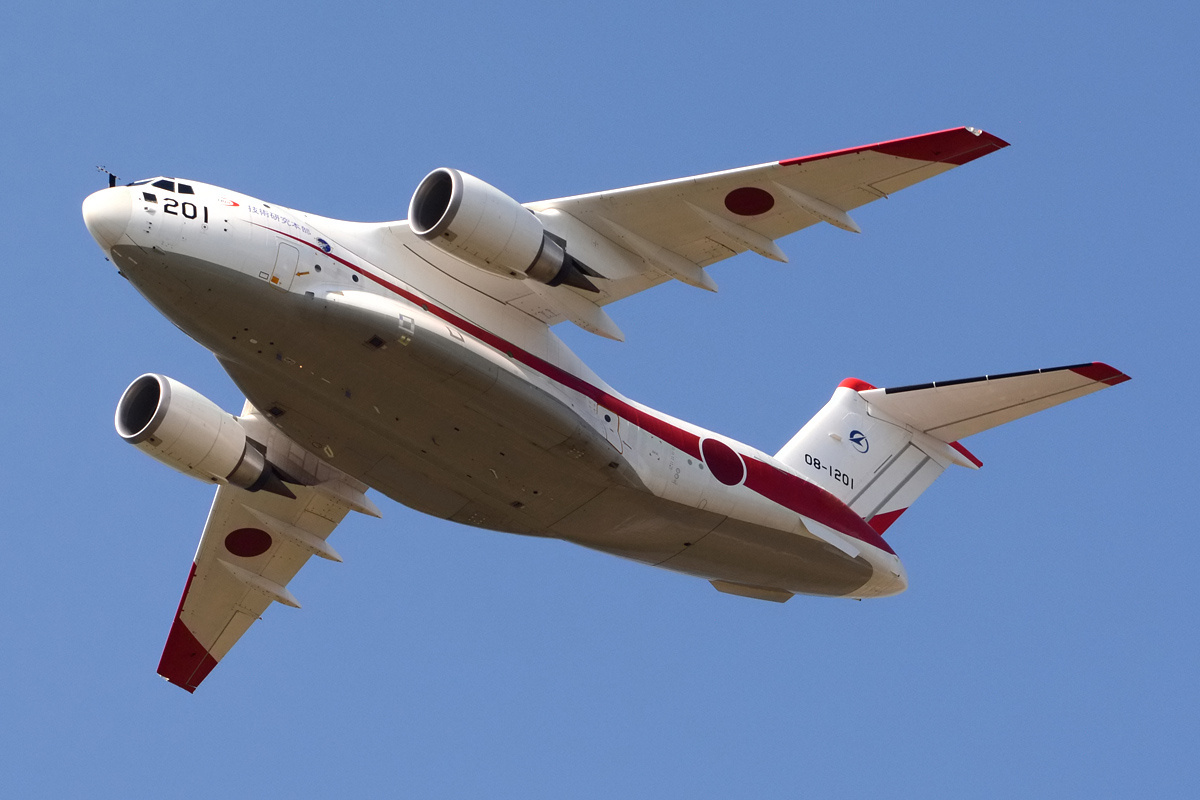




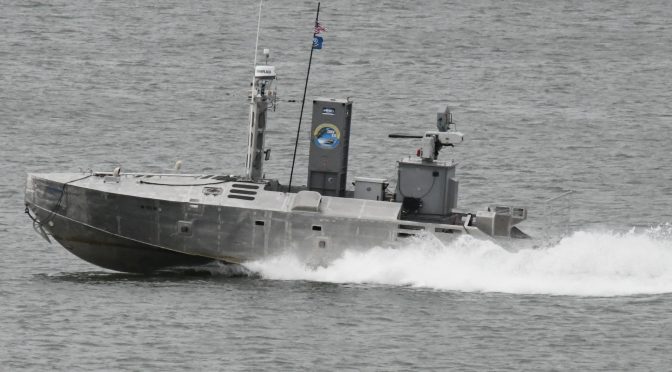
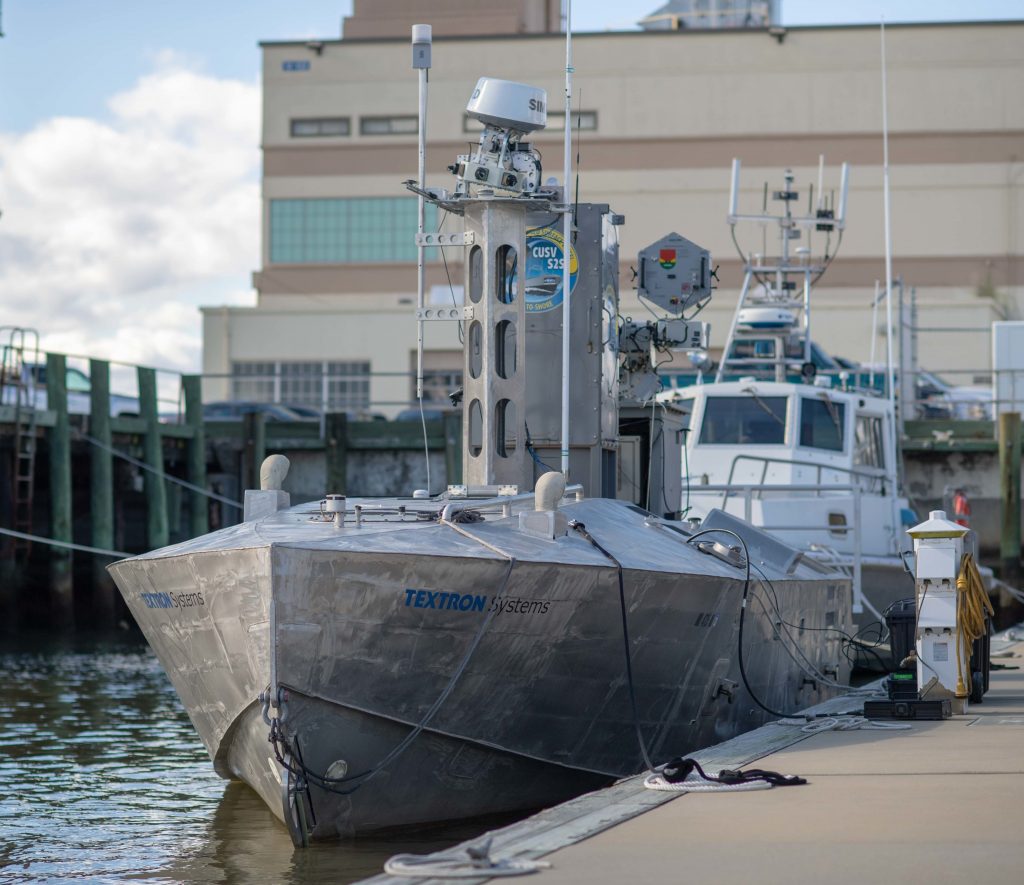
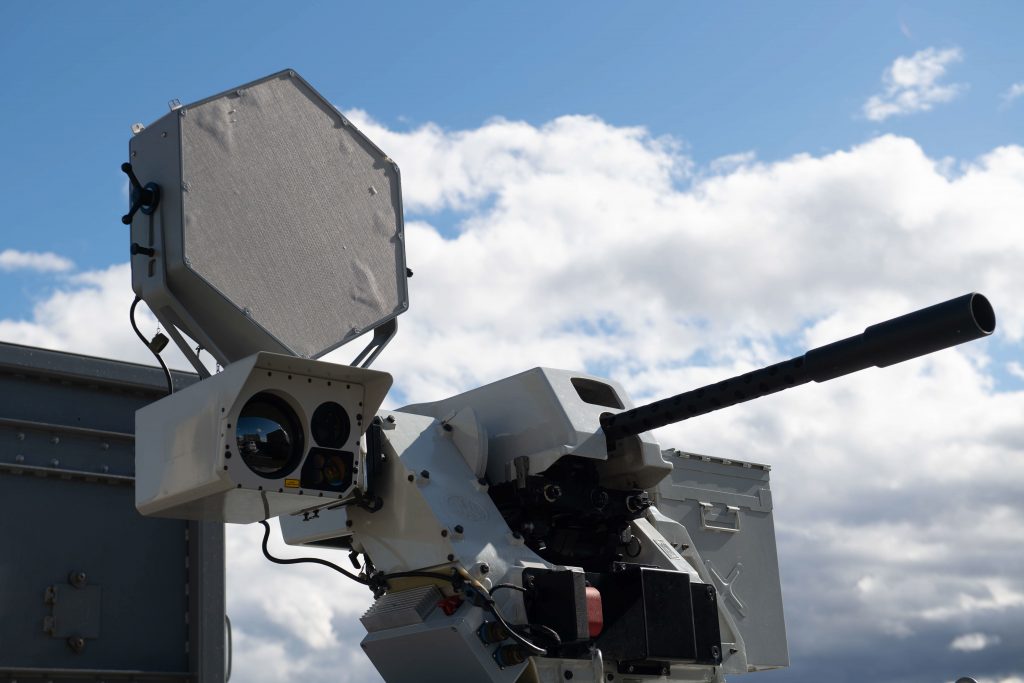
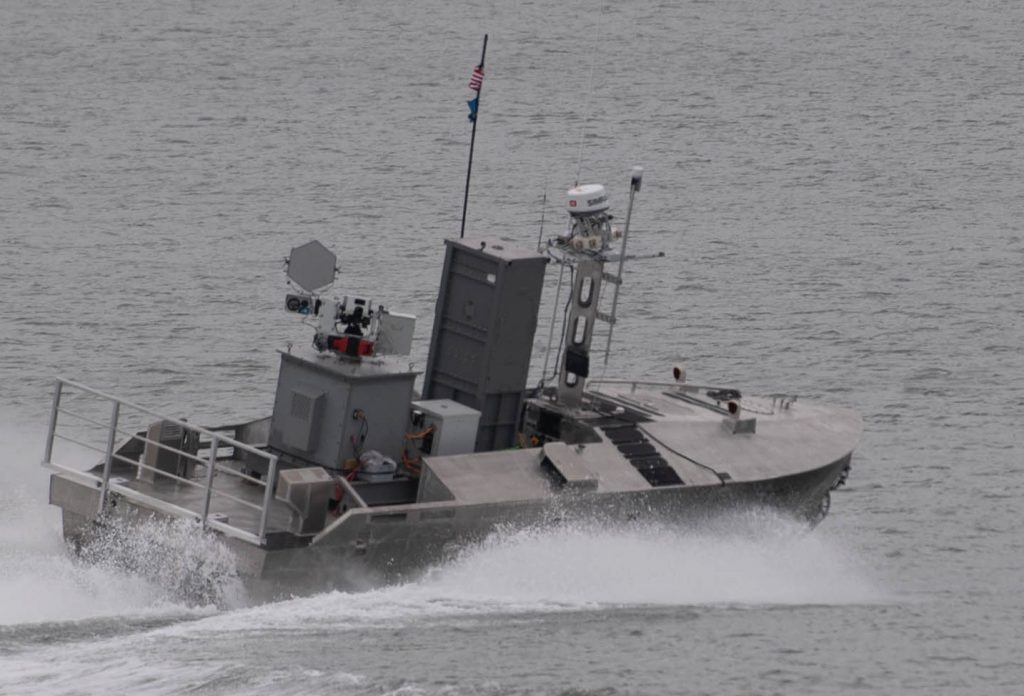
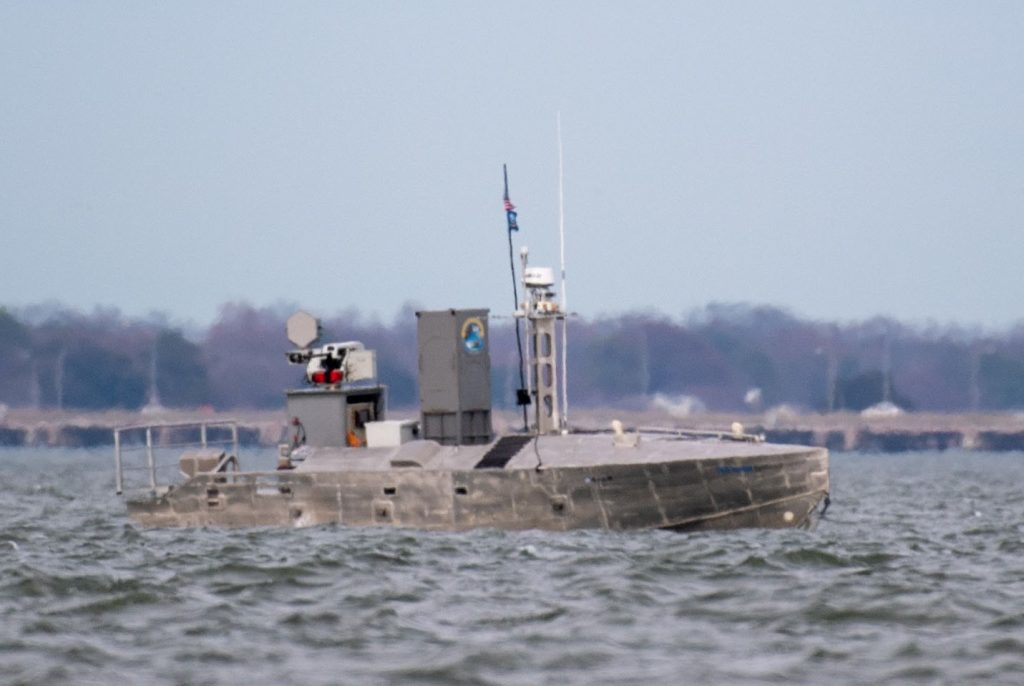
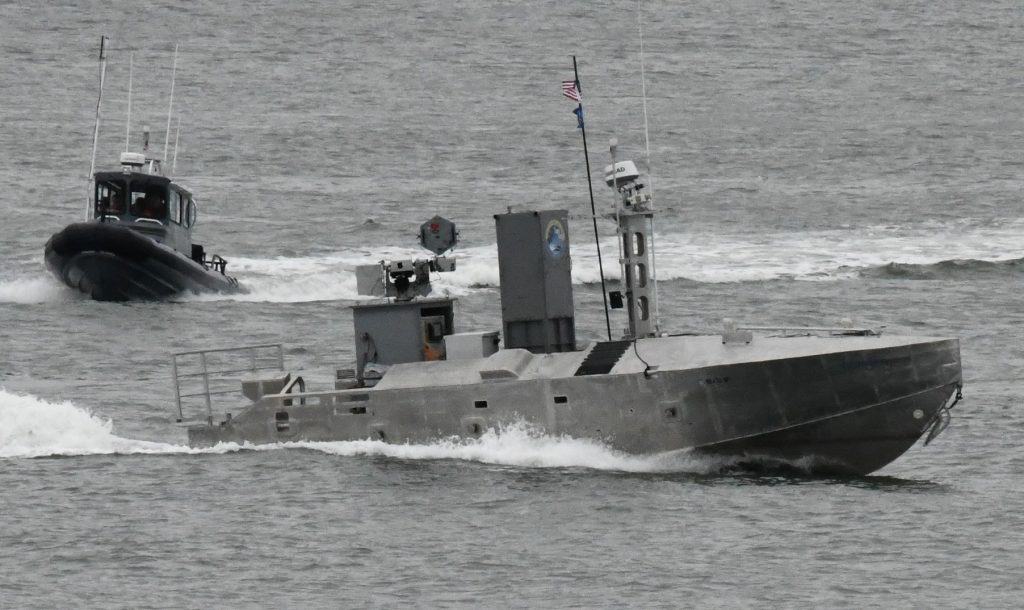
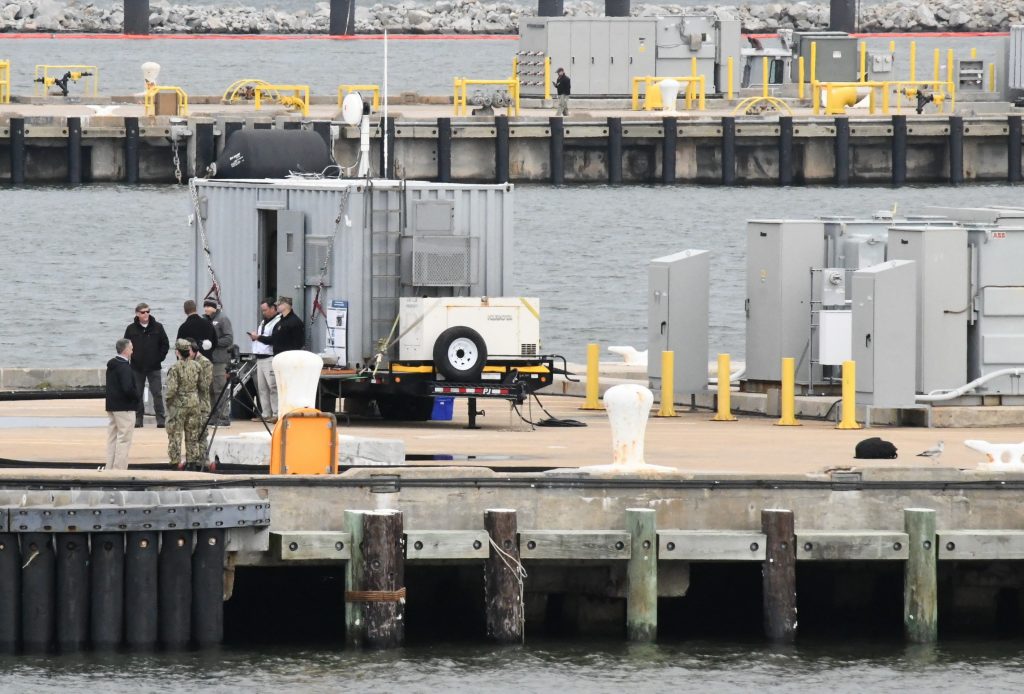
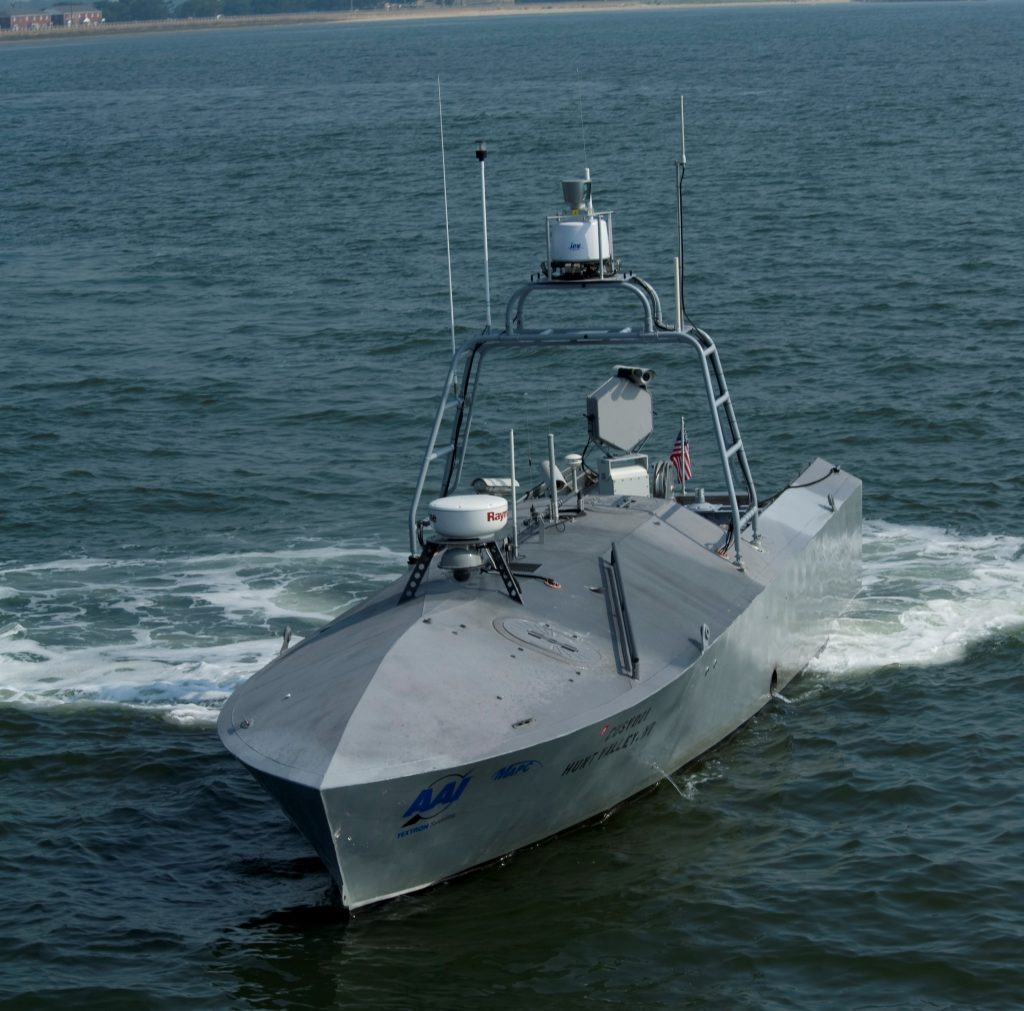
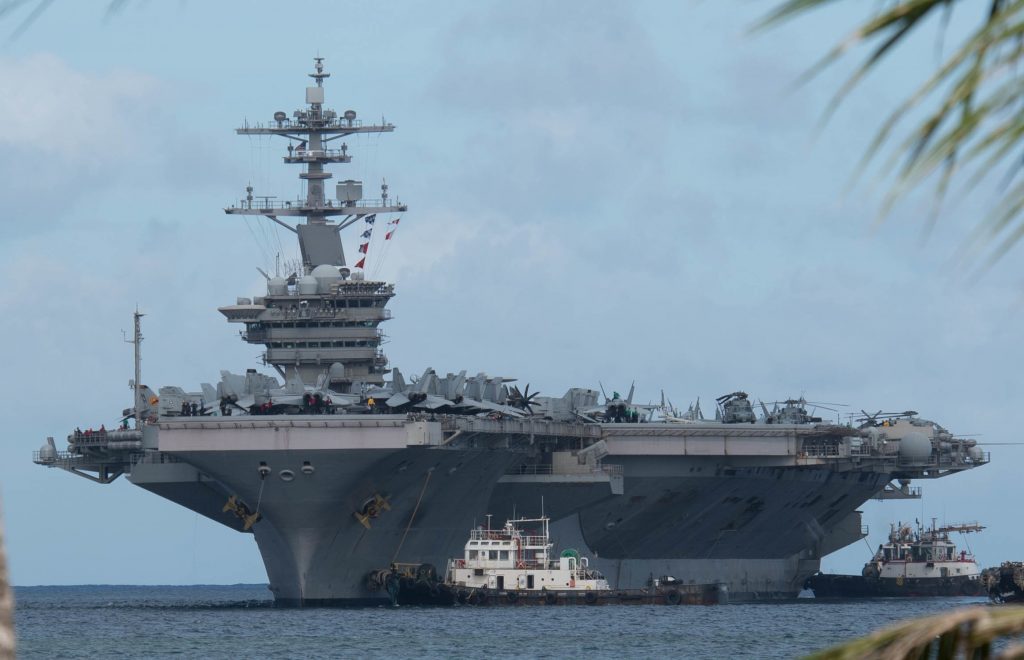
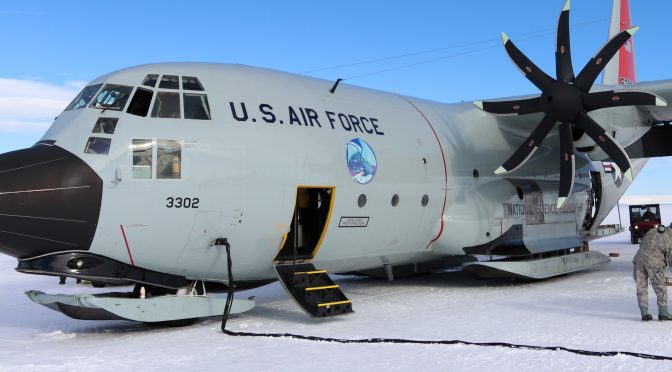
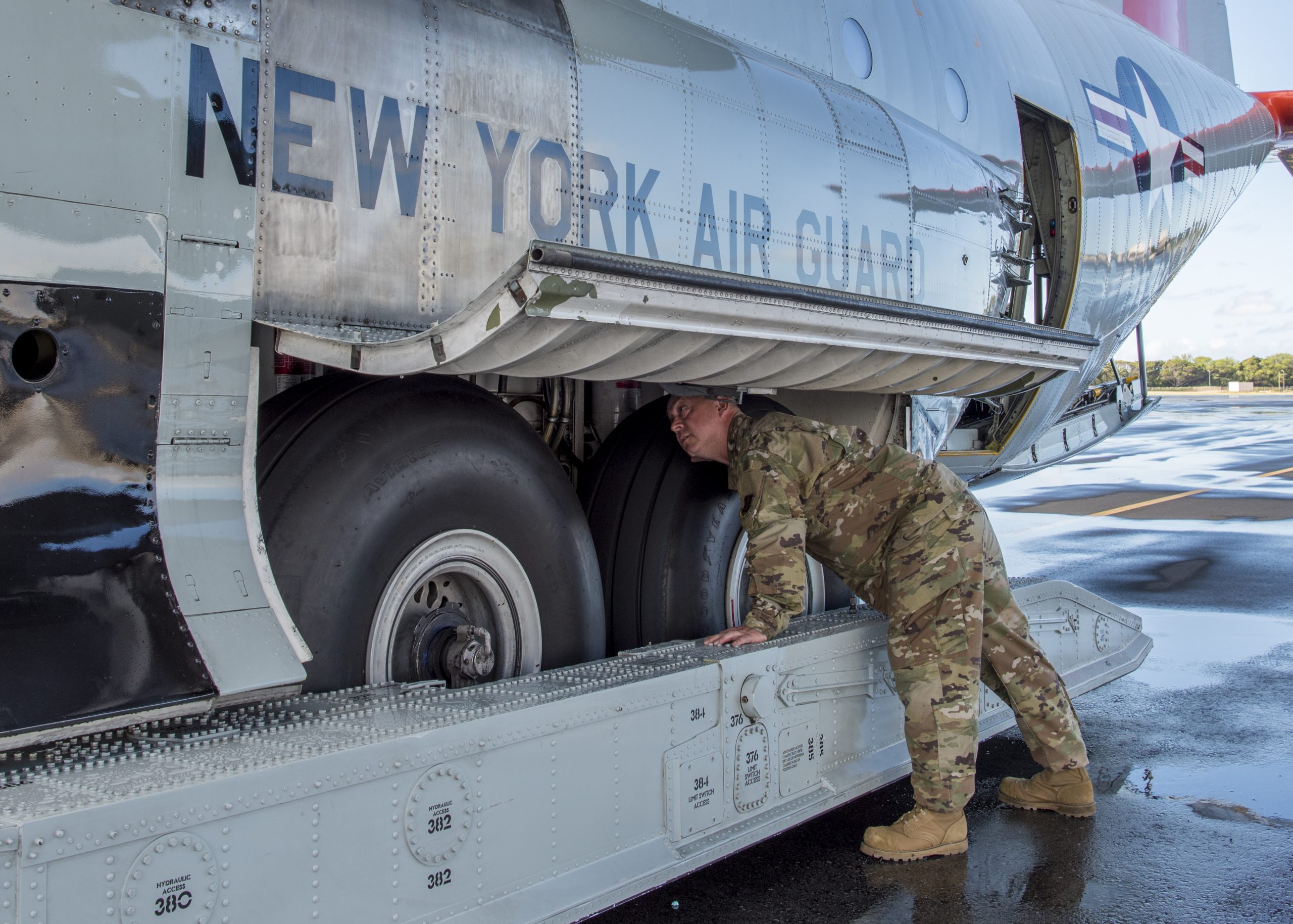
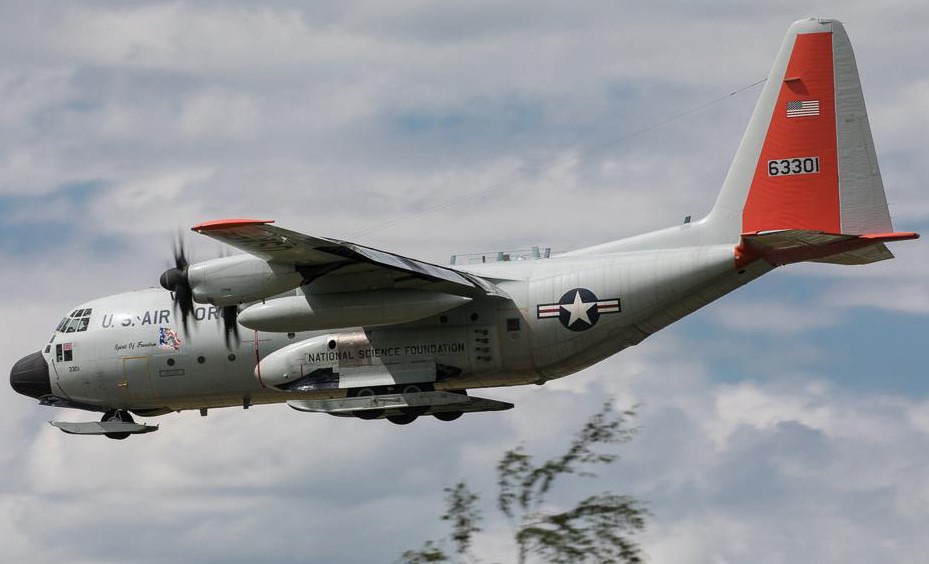
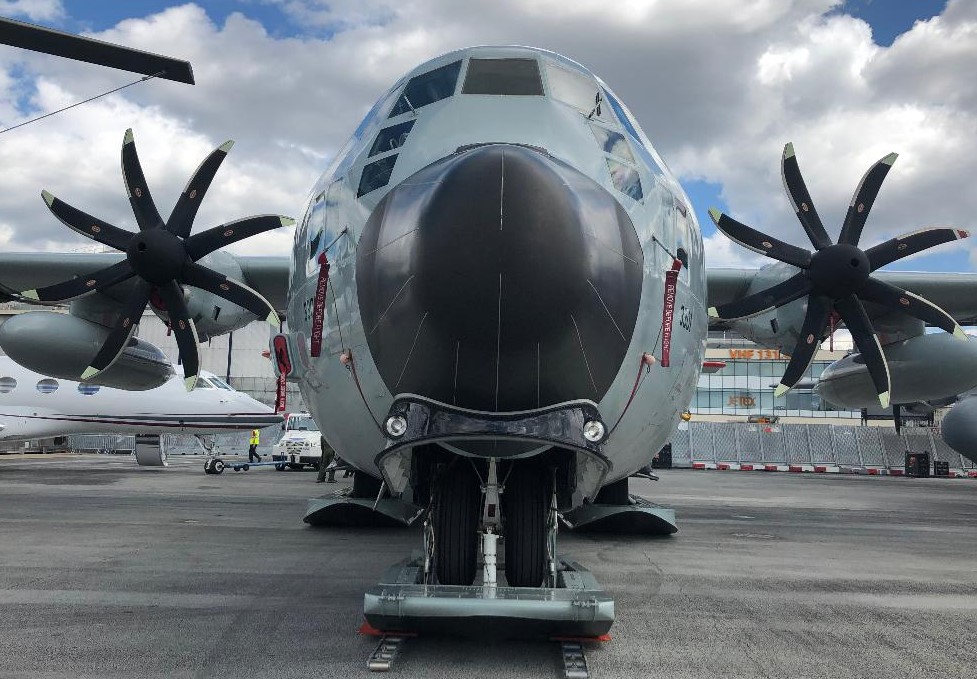
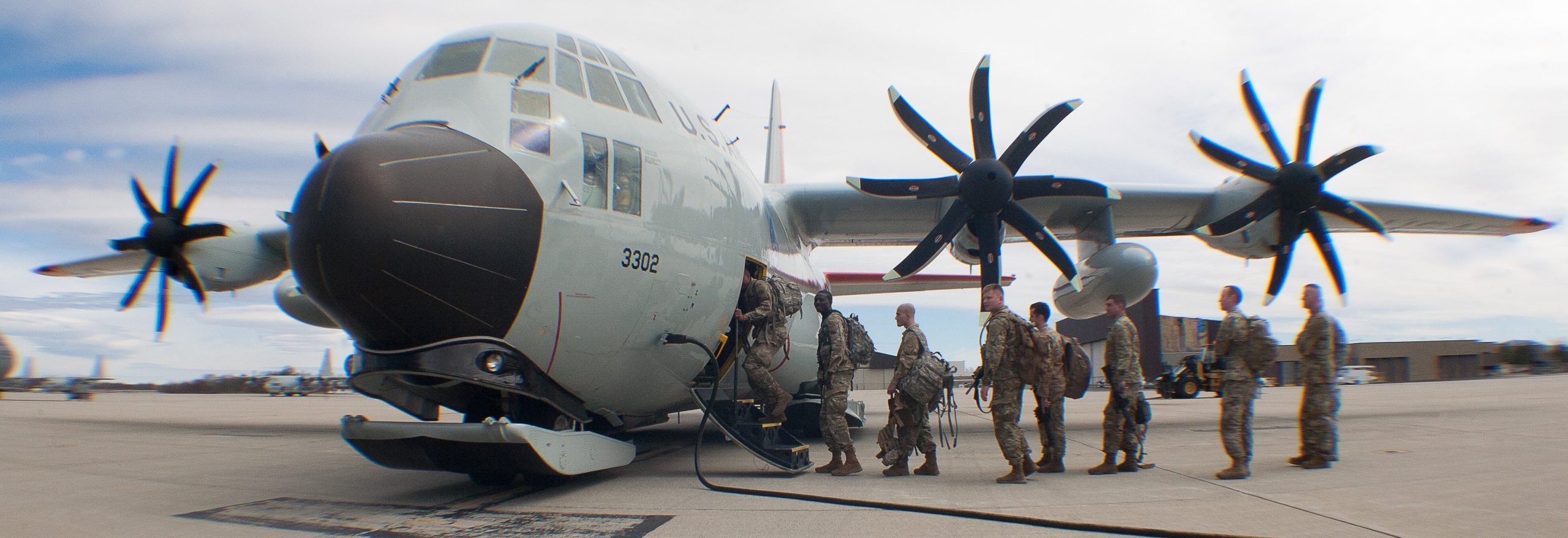

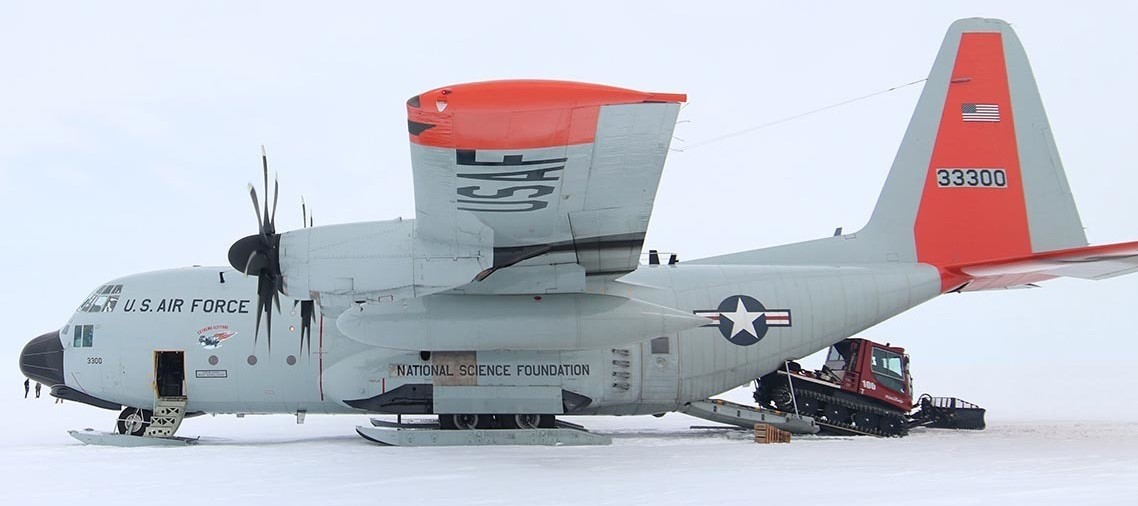
 New York Air National Guard’s 109th Airlift Wing’s LC-130, McMurdo Station, Antarctica 15JAN2019.
New York Air National Guard’s 109th Airlift Wing’s LC-130, McMurdo Station, Antarctica 15JAN2019.
 New York Air National Guard’s 109th Airlift Wing LC-130 (upgraded with evil British empire Rolls-Royce T56 series 3.5/NP2000 props), McMurdo Station, Antarctica, 17DEC2018.
New York Air National Guard’s 109th Airlift Wing LC-130 (upgraded with evil British empire Rolls-Royce T56 series 3.5/NP2000 props), McMurdo Station, Antarctica, 17DEC2018.


 Grass field take-off? No, it’s the camera angle. NY National Guard’s LC-130 takes off for Antarctica, 06SEP2018.
Grass field take-off? No, it’s the camera angle. NY National Guard’s LC-130 takes off for Antarctica, 06SEP2018.
 LC-130(F-H?) in Antarctica, 23JUL2017.
LC-130(F-H?) in Antarctica, 23JUL2017.

 The Common Science Support Pod, or IcePod, houses a variety of instruments to meausure changes in the Antarctic ice sheet.
The Common Science Support Pod, or IcePod, houses a variety of instruments to meausure changes in the Antarctic ice sheet. Some ‘scientist’ from Colombia University explaining how the IcePod works. To find out more go here:
Some ‘scientist’ from Colombia University explaining how the IcePod works. To find out more go here: 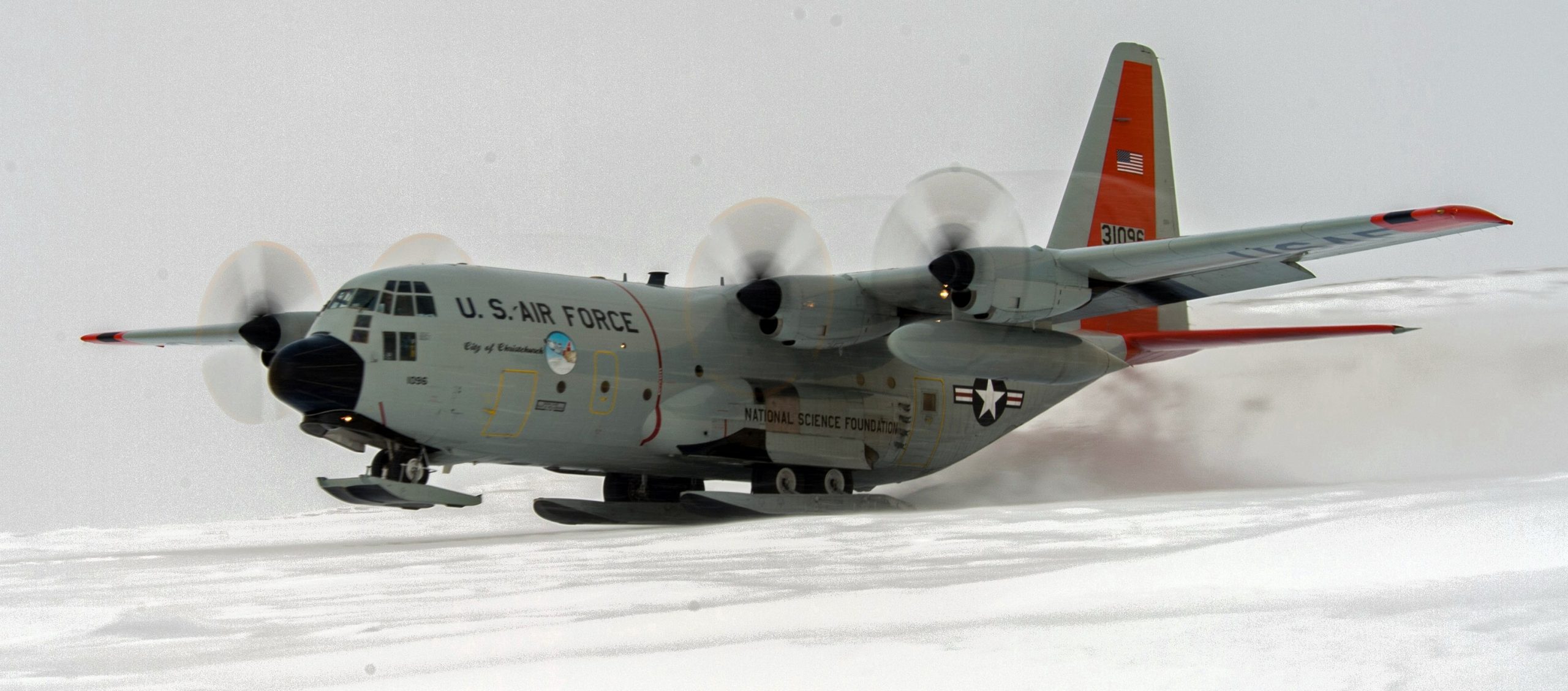
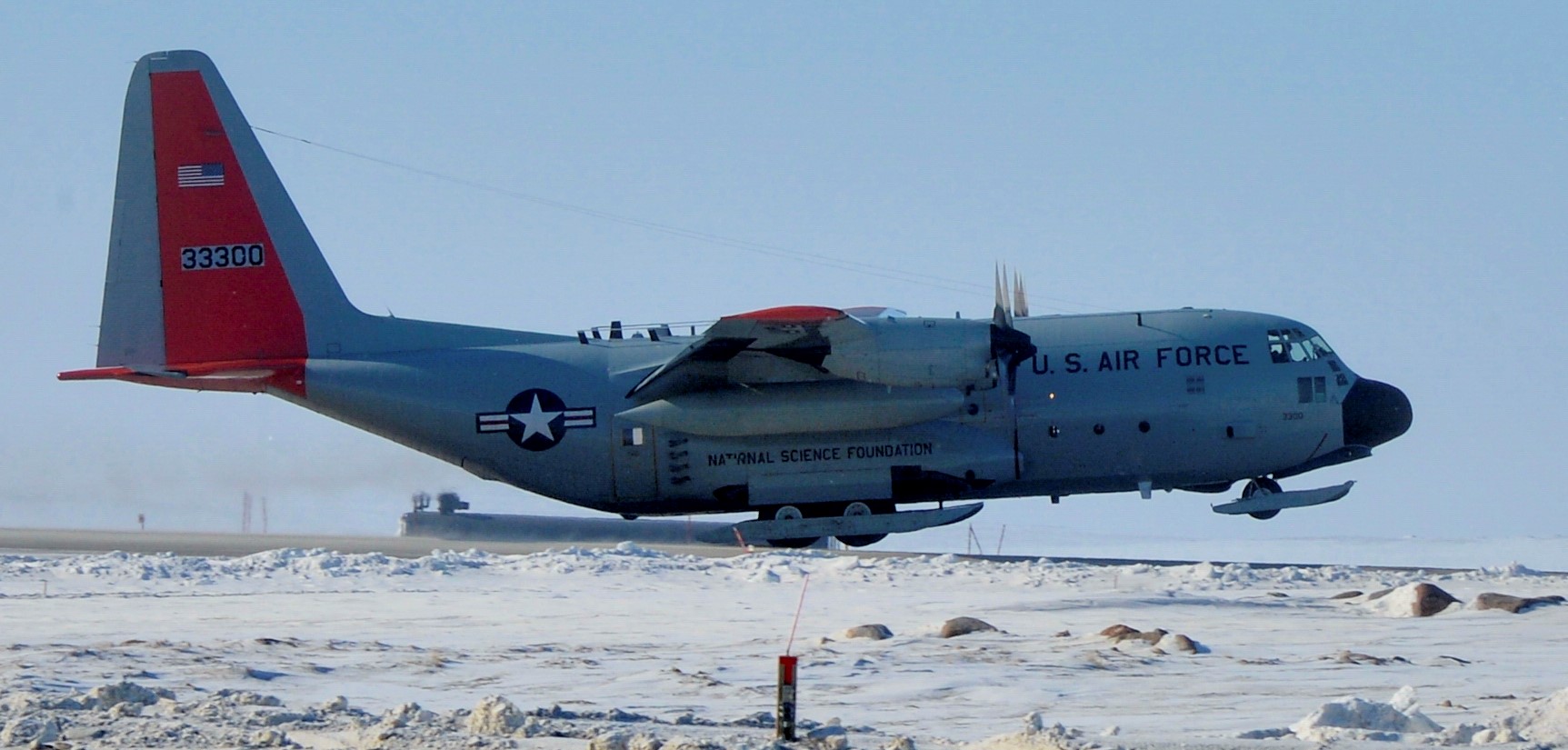
 Kangerlussuaq, Greenland, 27JUN2016.
Kangerlussuaq, Greenland, 27JUN2016. January 2014, Pegasus Field, Antarctica, problems with landing gear being rectified.
January 2014, Pegasus Field, Antarctica, problems with landing gear being rectified.

 Leaving Antarctica, 02FEB2011.
Leaving Antarctica, 02FEB2011. McMurdo Station, Antarctica, 2007.
McMurdo Station, Antarctica, 2007. Rocket assisted take-off from Greenland, 2003. For some reason it’s officially called Jet Assisted Take Off (JATO) even though it’s actually rockets. With the new Rolls-Royce T56 series 3.5 turbine/NP2000 props JATO is no longer needed.
Rocket assisted take-off from Greenland, 2003. For some reason it’s officially called Jet Assisted Take Off (JATO) even though it’s actually rockets. With the new Rolls-Royce T56 series 3.5 turbine/NP2000 props JATO is no longer needed.


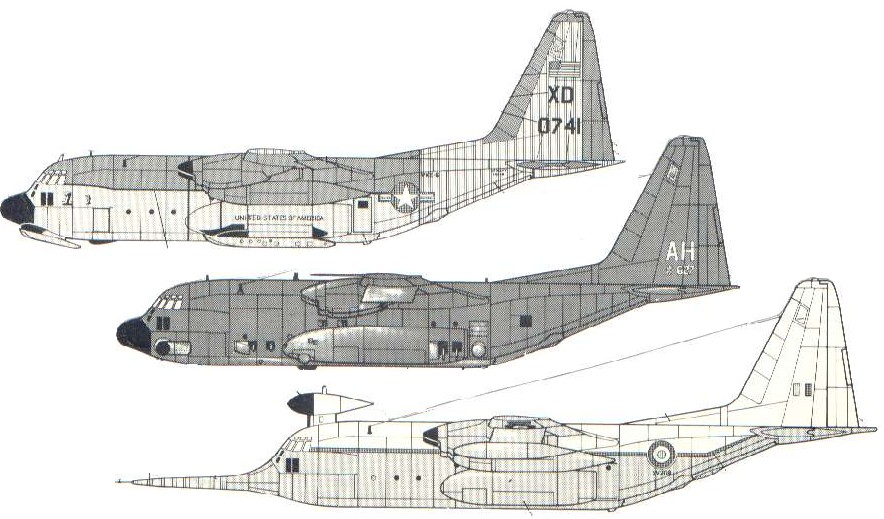
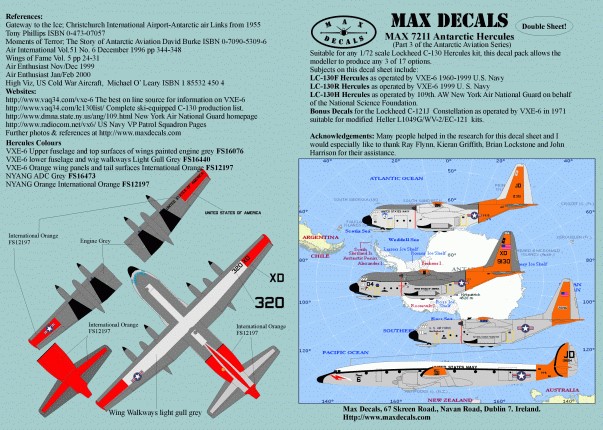
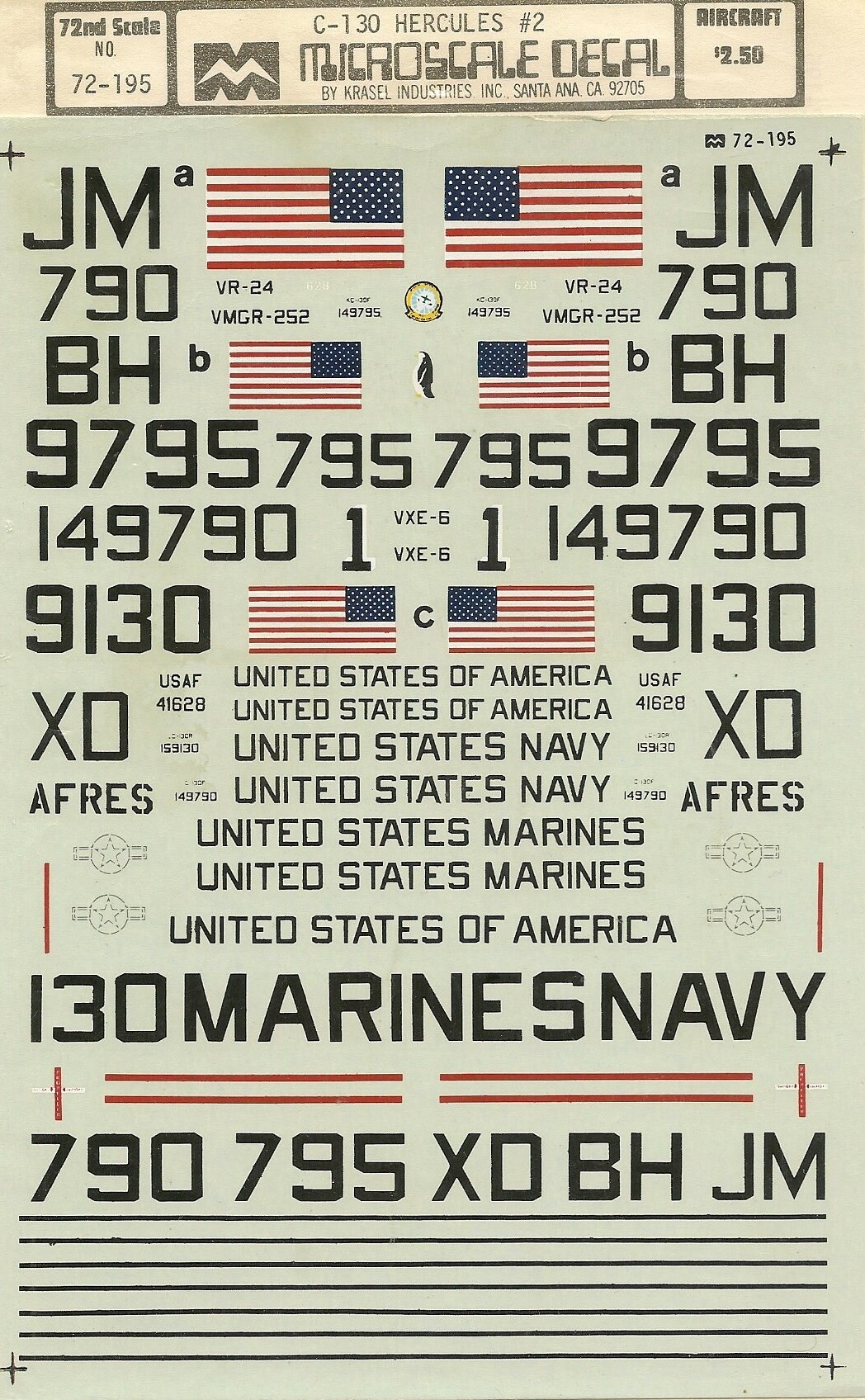
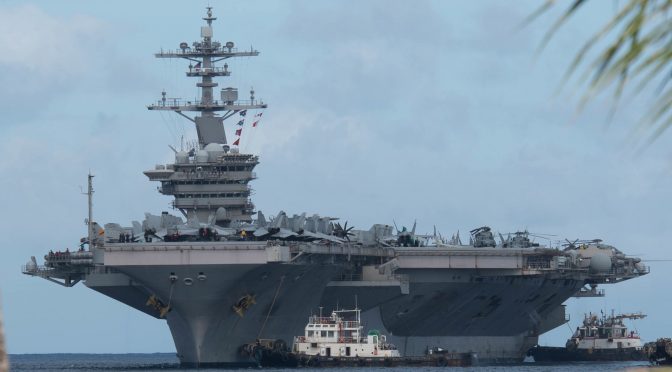




 CVN-71 on its way to Guam, 25JAN2020.
CVN-71 on its way to Guam, 25JAN2020.





 Leaving San Diego, 17JAN2020.
Leaving San Diego, 17JAN2020.



 Scrubbing the deck in 2013.
Scrubbing the deck in 2013. Leaving Newport News Shipyard in 2013, after four years of overhaul.
Leaving Newport News Shipyard in 2013, after four years of overhaul.





 2009, when CVN-71 began its overhaul.
2009, when CVN-71 began its overhaul.


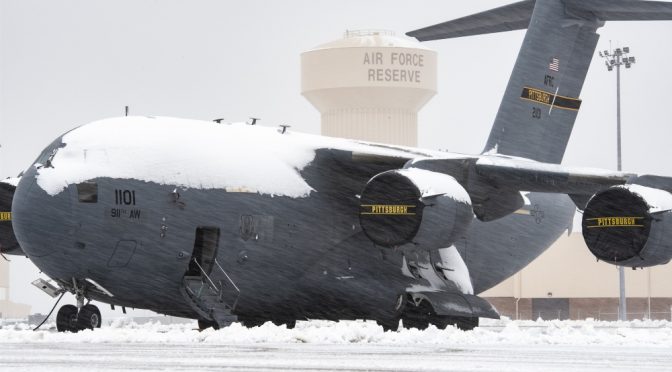
 C-17s of the 911th Airlift Wing, Pittsburgh International Airport Air Reserve Station, Pennsylvania, 07FEB2020.
C-17s of the 911th Airlift Wing, Pittsburgh International Airport Air Reserve Station, Pennsylvania, 07FEB2020.






